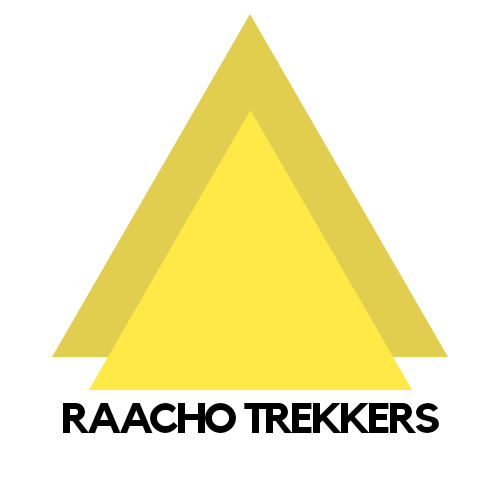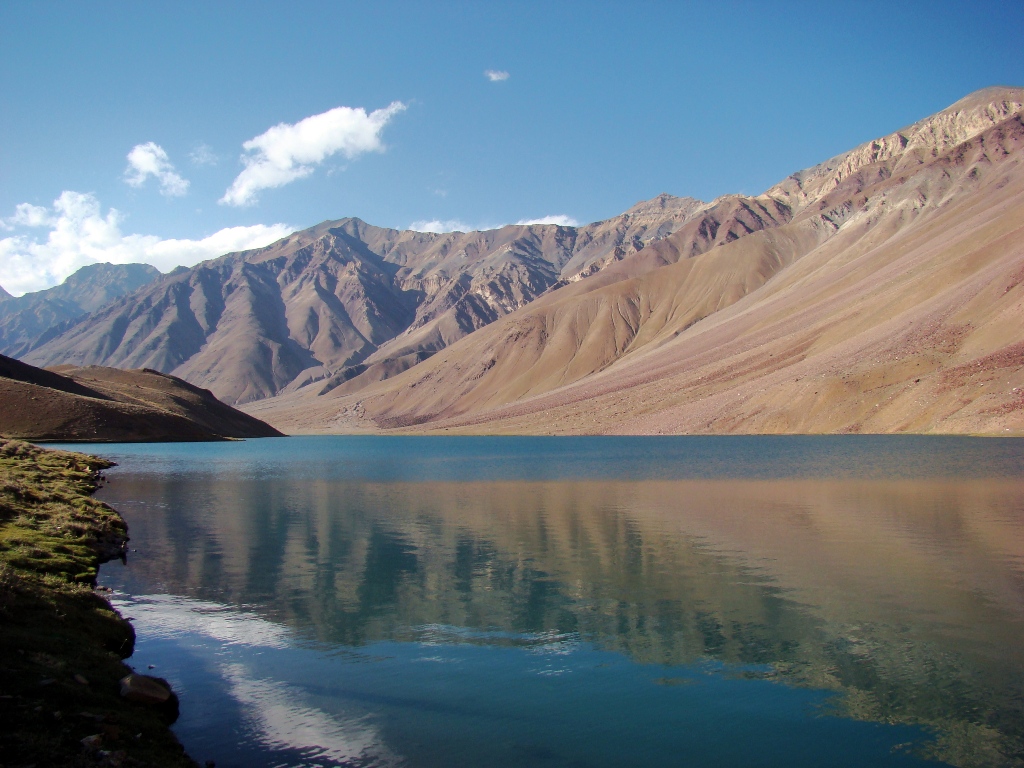Spiti Valley is a cold mountain desert located in the rain shadow region of the Greater Himalayan ranges. It is snuggled in the north-eastern part of Himachal Pradesh.
In counterclockwise direction from Chandigarh, Spiti Valley circuit route takes you through Solan, Shimla, Narkanda, Rampur Bushahr, Sarahan, Chitkul, Kalpa, Nako, Tabo, and Kaza on the National Highway 5 (NH5) and and its peripherals.
The closing line of Spiti circuit traverses along the Spiti river and meets Manali town after passing through the Atal tunnel or Rohtang pass.
The valley is bordered by the districts of Kinnaur in the south-east, Kullu in the south, and the valleys of Zanskar and the Union Territory of Ladakh in the north. In the east, Spiti shares its boundary with Tibet (China).
The name Spiti or Piti — as it is known among the locals— means ‘The Middle Land’ that is the land between India and Tibet.
⚡Rundown of Spiti Valley Trip
| Days | 12 |
| Vehicle | Mahindra Getaway 4WD or Toyota Innova Crysta cars |
| Stay | Camping + Hotels + Homestays |
| Highest Place | Kunzum-La (pass) 4551 meters |
| Highest Village | Komic 4513 meters |
| Best time to hit the road | May to October |
| Route | Chandigarh-Shimla-Kinnaur-Spiti-Manali-Chandigarh |
| Road distance to cover | ~ 1200 km |
| Departure dates | May 29, June 6 & 20, 28 August, and between September 1 and 15 |
| Group size | Max 10 |
| Event Category | Road trip & cultural experiences |
| Package Type | Personalized/Standard |
Departures in 2025
Tour departure dates for our Spiti valley circuit are scheduled for the last weekend of May, the second and third weeks of June, the last week of August, and between 1 and 15 September 2025.
We also can run personalized trips — tailored to your interests and travel plans — for smaller groups (less than 4 people) and for people willing to incur an additional cost. Trip dates are subject to weather and road conditions, as determined by Shimla, Kinnaur and Lahaul & Spiti district administration.
🚘 Spiti Tour (via Chandigarh to Shimla-Kinnaur-Kaza-Manali)
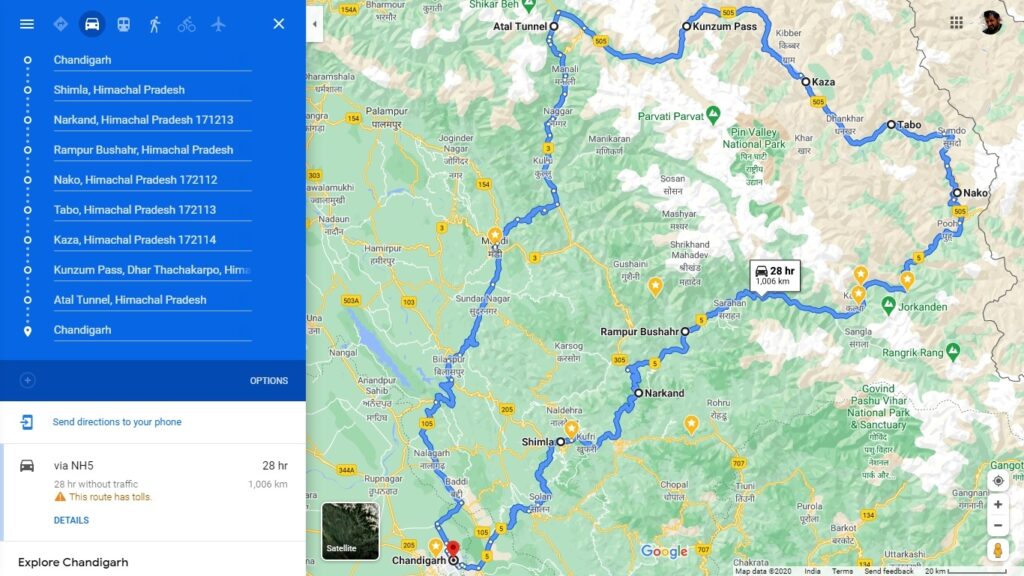
Why take Shimla-Kaza-Manali route for Spiti Valley Road Trip?
The Chandiarh-Shimla-Kinnaur-Kaza route is recommended for Spiti Valley Circuit raod trip because:
- Manali to Solang valley and Atal tunnel (north portal) road stretch gets busy during peak summer season (i.e. June-August). You may get stuck in a traffic jam.
- Gramphu to Batal Road is riddled with waterfalls, glacial water melts streams, and water crossings. It is easier and more convenient to drive through this part of the road from Kaza side.
- There is a gradual increase in altitude (barring Narkanda-Rampur Road segment) when driving on the Chandigarh-Shimla-Kaza route. This gradual rise in altitude is good for acclimatization. Especially for people coming from the Indian plains.
What Does It Cost?
All-inclusive price of Spiti valley tour starts from 25,500 INR. The final price will be determined by variables like:
- Vehicle (4WD SUV or standard)
- The level of comfort (during stays) you expect.
- Group size.
- Pick-up location (Delhi, Chandigarh, Shimla or Manali)
- Departure date (pre-monsoon in June or post-monsoon in September or October)
- Add-ons availed such as driver, camping gear and guide, and drop location (Shimla, Manali, Chandigarh, or Delhi) etc.
To get the Spiti valley circuit tour cost details, please let us know the following details:
- The group size
- Arrival city (Chandigarh/ Shimla/Manali), and tour type (standard/premium) etc.
- Planned month and day of visit
- Number of days in itinerary
- Mode of transportation i.e. 4WD SUV / Sedan / Hatchback car.
Spiti valley and upper Kinnaur is a remote region with high-altitude rugged and difficult terrain. Expect stunning and spectacularly beautiful vales with dreamy vistas instead of fancy hotels or road tracks similar to F1 grand prix circuits.
Drop an email to avail group offers & early bird discounts.
⛗ Spiti Circuit Tour Itinerary From Shimla
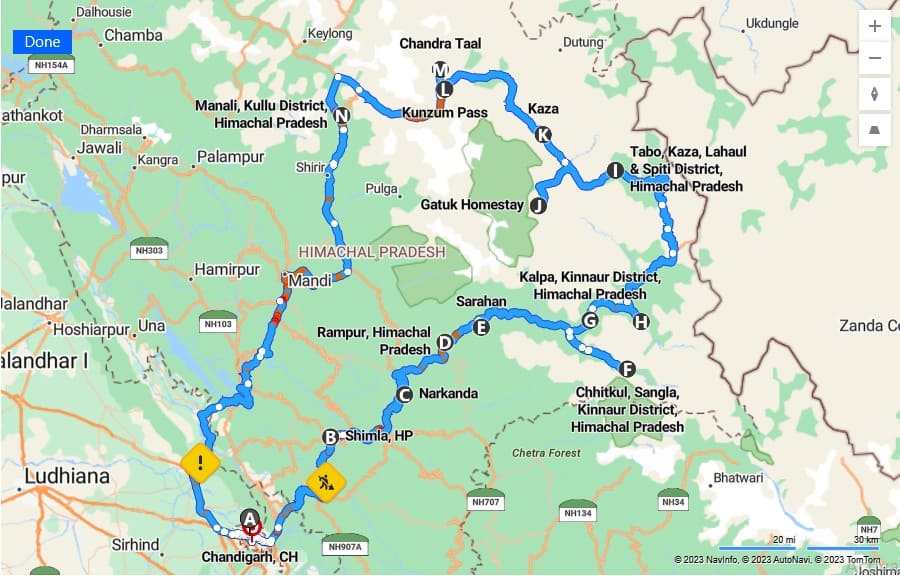
Day 1: Chandigarh to Shimla-Narkanda Drive
Bucketlist Experiences
- Timber trail.
- Kasauli detour
- Shimla colonial architecture heritage walk.
- Experience 360° view from Hatu peak
Distance 175 km. 6–7 hours drivetime on NH5
On arrival at Chandigarh, drive to Shimla. Halt at Shimla for lunch and sightseeing. Resume the drive and drive to Narkanda(8,858 feet). Overnight stay at HPTDC hotel.
Day 2: Narkanda to Sarahan Drive
Bucketlist Experiences
- Visit Padam palace of erstwhile Bushahr dynasty.
- Explore Rampur Bushahr town.
- Explore Sarahan town.
Sightseeing Day Trips
- Detour to Tani Jubbar Lake
- Hatu temple
Distance 100 km. 4 hours drive time on NH 5 and Jeori-Sarahan connecting road
Drive from Narkanda to Sarahan (altitude 2800 meters). Visit Hatu temple en route and relish Dhauladhar and Kinnaur-Garhwal mountain ranges from there. Drive to Sarahan. Overnight at the hotel.
Day 3: Sarahan to Chitkul Village of Kinnaur
Bucketlist Experiences
- Drone photography at Tranda Dhank (built by Governor General Dalhousie in 1850s.
- Experience driving by steep Satluj river gorge and through Tranda Dhank (cliff) ― Old Hindustan–Tibet Road section that is carved into a rock face.
- Angling in Baspa river.
- See Western Tragopan (Jajurana) in Sarahan Pheasantry.
Sightseeing Day Trips
- Visit Sarahan Palace (Shanti Kunj) of Bushahr dynasty.
- Bhimakali temple visit.
- Sarahan Western Tragopan Pheasantry visit.
Distance 106 km. 5 hours drivetime on Jeori-Sarahan connecting road, NH5 and Karcham-Sangla-Chitkul Road
Sarahan is a beautiful village famous for the architecturally and historically significant Bhimakali temple, which has a history of more than 1500 years. One can take in the stunning views of the Srikhand Mahadev peak (5150 meters) from there.
While not actually close enough as it seems, the spectacular Srikhand Mahadev mountain range appears as if it is just an arm’s length away. Visit the bird sanctuary of a near-extinct bird species.
Drive to Chitkul village and stay there in a hotel. Drive distance is about 106 Kms. Night stay at hotel in Chitkul.
Day 4: Chitkul to Kalpa drive
Bucketlist Experiences
- See temple architecture of Kamru Badri Vishal deity temple.
- See Kamru fort.
- Angling in Baspa River.
- Tibetan wood carving center.
- Sangla monastery.
- Temple architecture of Sangla Bering Nag Temple.
- Hike to Sangla Kanda Lake
- Chitkul village walk.
- Explore Sangla town and village.
- Rakcham village.
- Photography in Buckwheat fields of Rakcham village.
Sightseeing Day Trips
- Chitkul Mata Devi temple and monastery visit.
- Kamru temple and fort.
- Ranikanda meadows visit.
- Sangla village and Bering Nag temple visit.
Distance 62 km. 3 hours drive time on Chitkul-Sangla-Karcham road, NH5 and Powari-Kalpa connecting road.
Chitkul (at 3400 meters above sea level), is the last village on the Indo-Tibet border. It is the most visited place in the Baspa Valley of Kinnaur.
We will visit Chitkul Mata temple and then drive back to Sangla. When we reach Sangla, we can visit the Bering Nag temple on our return trip. Visit the ancient fort at Kamru village.
As we continue on our journey, we will reach Kalpa, a well-known place – both among travellers and locals – for breathtaking sunrises over the Kinnaur Kailash mountain range.
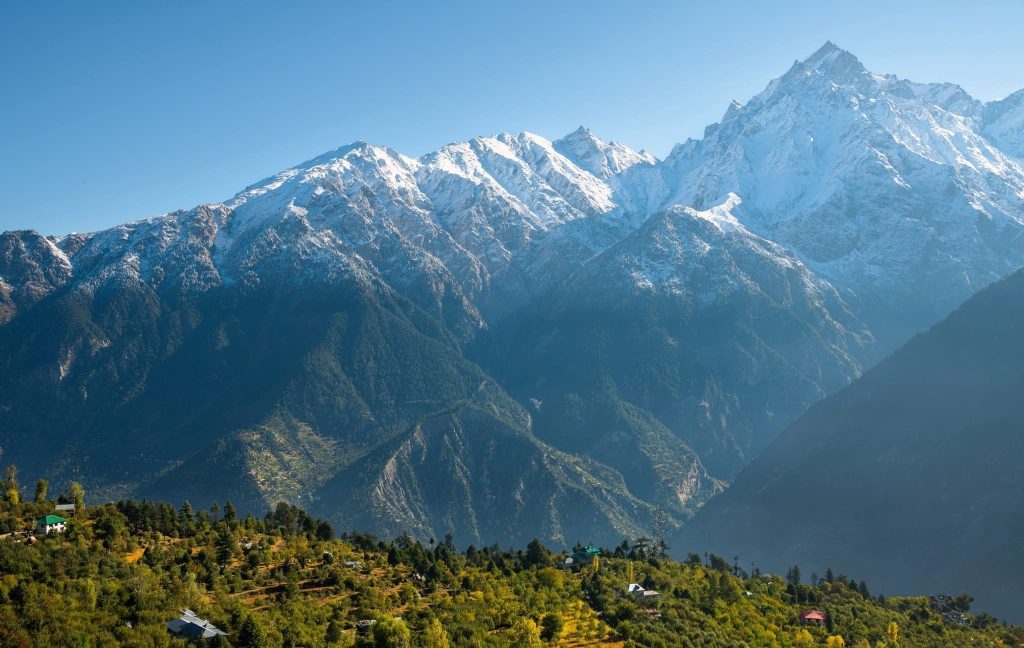
After breakfast, drive (65 km distance) to Kalpa that is located at 8800 feet. Visit Chini village monastery and temple, Roghi cliff point and Roghi village. Overnight stay at the HPTDC Kalpa hotel.
Day 5: Kalpa to Charang village
Bucketlist Experiences
- Explore Chini heritage village.
- Explore Kalpa Market
- Take in the stunning views of Kinner Kailash group of mountains (morning and evening views are unparalleled) from Kalpa.
- Spend time with local people of Kalpa and Roghi village.
- Visit 170+ year old Roghi Forest Rest House built by Governor General Dalhousie.
Sightseeing Day Trips
- Rolla Dokhang (infamous suicide point), and Roghi village visit.
- Roghi village and Narayan temple visit.
- Kalpa Vishnu Narayan temple and monastery visit.
Distance 60 km. 3 hours drivetime on Kalpa-Powari connecting road, NH5 and Moorang-Thangi-Charang road.
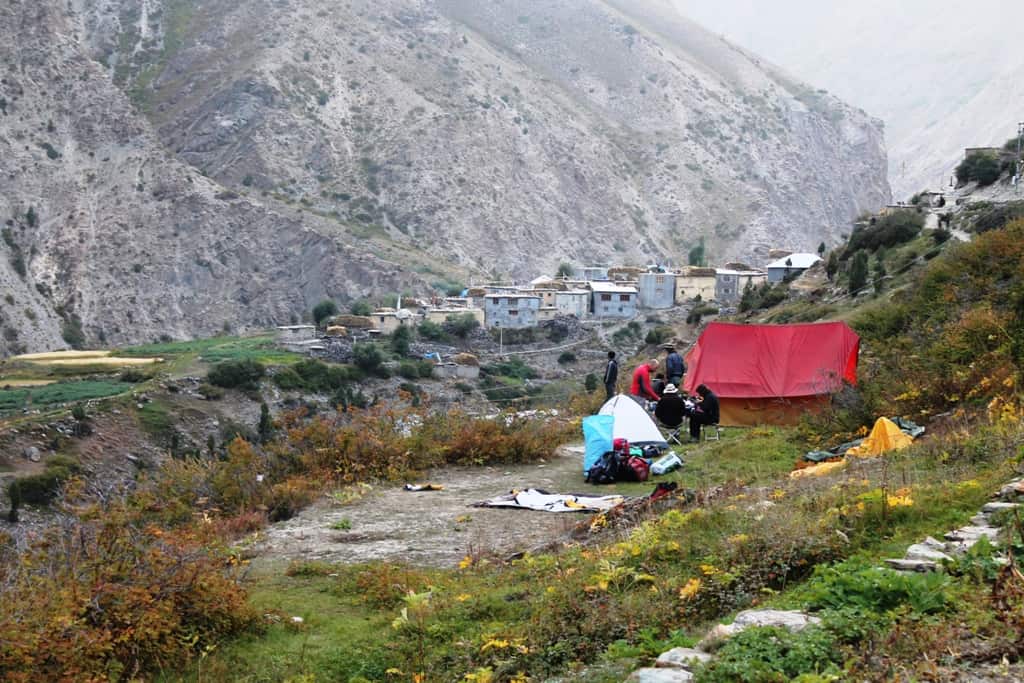
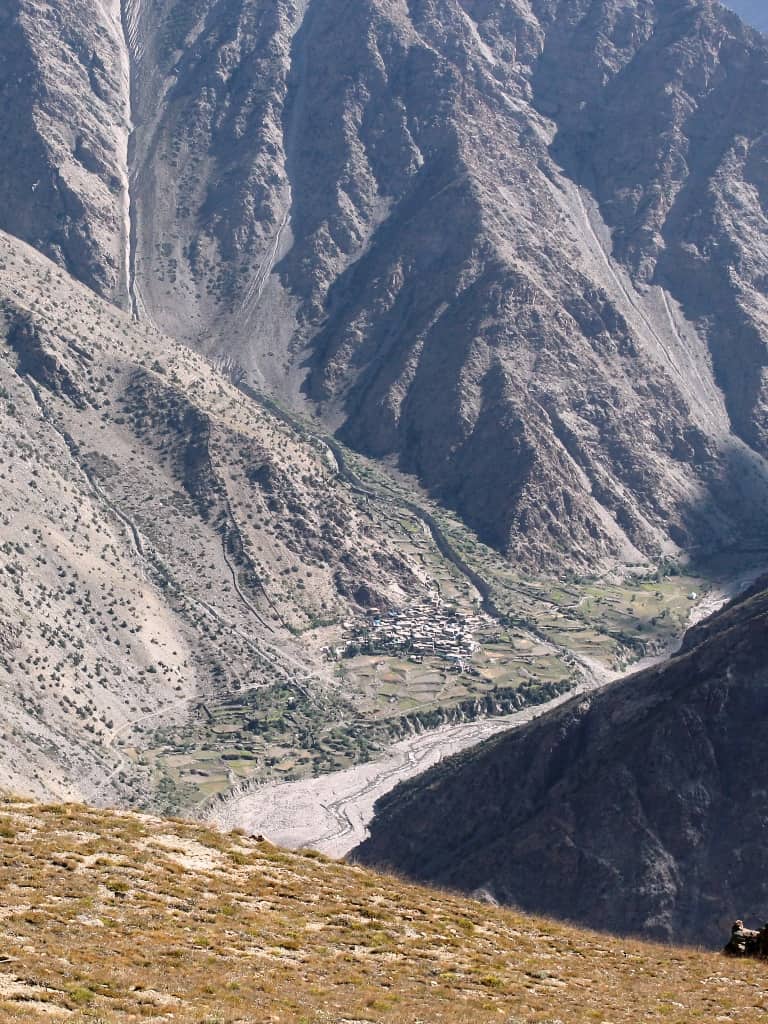
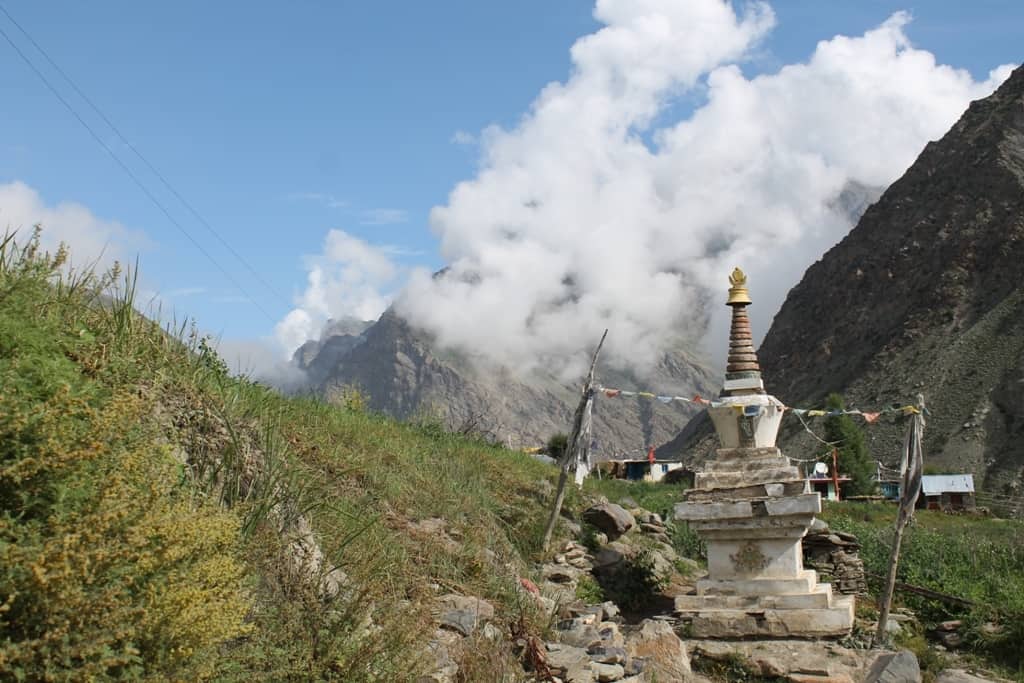
Kalpa (altitude 3000 meter). Kalpa offers a splendid view of Kinner Kailash mountain range. One can take in the visceral views of Kinner Kailash peak & Shivlingam, Raldang peak & Jorakanden peak.
Explore places around Kalpa like Chini market and village, monastery and Kalpa Narayanes & Vishnu temple. Drive to Charang village & camp there.
Day 6: Charang to Tabo monastery drive
Bucketlist Experiences
- Visit one of the oldest Buddhist monasteries in Kinnaur, Charang Rangrik Tsungma monastery.
- Visit Moorang village fort and Buddhist monastery.
- Visit Rapuk Shankras Temple of Thangi village.
- Explore Nako village and Nako Lake.
- Gue village detour to see 500+ years old mummy and Gue Mummy Stupa.
- Leo-Chango-Hango village (Hangrang valley) detour.
Sightseeing Day Trips
- Charang village walk.
- Rangrik Tsungma Monastery visit.
- Visit last ITBP check post on Indian border.
Distance 160 km. 5 hours drive time on Charang-Thangi-Moorang road, NH5 and NH505 (Khab – Sumdo Checkpost – Tabo)
Village walk in Charang (altitude 3400 mtr) and visit Rangrik monastery which is more than thousands of years old. Charang has Zanskar kind of landscape and houses and similar to houses built by the people of Zanskar region.
Drive to Thangi and visit to Lochwa monastery located in the middle of Thangi village. Visit Moorang fort and Moorang village.
After lunch, head toward Nako. Nako is located at an altitude of 10496 feet in the barren Hangrang valley of Kinnaur. Visit Nako Lake and monastery and drive to Sumdo check post and the oldest monastery of Himachal, Tabo. Overnight at a hotel/homestay.
Sumdo Check Post
Due to ever-increasing footfall of the tourists — and the resultant increase in their carbon footprint — in Lahaul and Spiti district, the district administration has started levying SADA (Special Area Development Authority) fee/toll at Sumdo Indian Army Check Post from 1 January 2024.
It was discussed (at a meeting of the Special Area Development Authority) that the tourist traffic is increasing day by day in the Spiti valley. Due to this, there is a financial shortage for solid waste management and sewage management in the Kaza and Tabo areas of Spiti block.
— Harsh Negi, SDM, Kaza
Here are the details of the SADA fee charged for different type of vehicles entering in Lahual & Spiti district.
| Type of vehicle | SADA fee |
| Two-wheelers | ₹ 100 |
| Cars | ₹ 200 |
| SUVs | ₹ 300 |
| Heavy Vehicles | ₹ 400 |
Day 7: Tabo – Pin Valley drive
Bucketlist Experiences
- See Thangka scroll paintings, frescos and mural paintings inside Tabo monastery.
- See mud stupas built around the monastery.
- Hike to Tabo caves (that were used by Buddhist monk of Tabo monastery for meditation).
- Visit Stupas and chortens, monastery museum and library.
- See the rock carvings near Tabo village government school.
- Visit over 1000-year-old Dhankar monastery and fort – A cliff fort and erstwhile capital of Spiti Nono Kings. Dhankar monastery was listed as 100 most endangered sites in the world by World Monuments Fund (WMF) in 2006. WMF is a New York based non-government and non-profit organization dedicated to the preservation of historic architecture and cultural heritage sites around the world.
- See the confluence of Spiti and Pin River and panoramic view of Spiti and Pin valley from Dhankar fort roof.
- Dhankar lake hike.
- See gold-leaf Buddhist sculptures at Serkhang Monastery of Lhalung village.
Sightseeing Day Trips
- Tabo monastery visit.
- Hike to caves above the village.
Distance 65 km. 3 hours drive time on NH505 (Tabo-Attargo bridge) and Attargo-Mud village road.
On day 7 of Spiti circuit itinerary, we leave Tabo after breakfast and drive to Mudh village, the last village in Pin valley. Pin Valley is the least explored valley in Himachal Pradesh’s Spiti region.
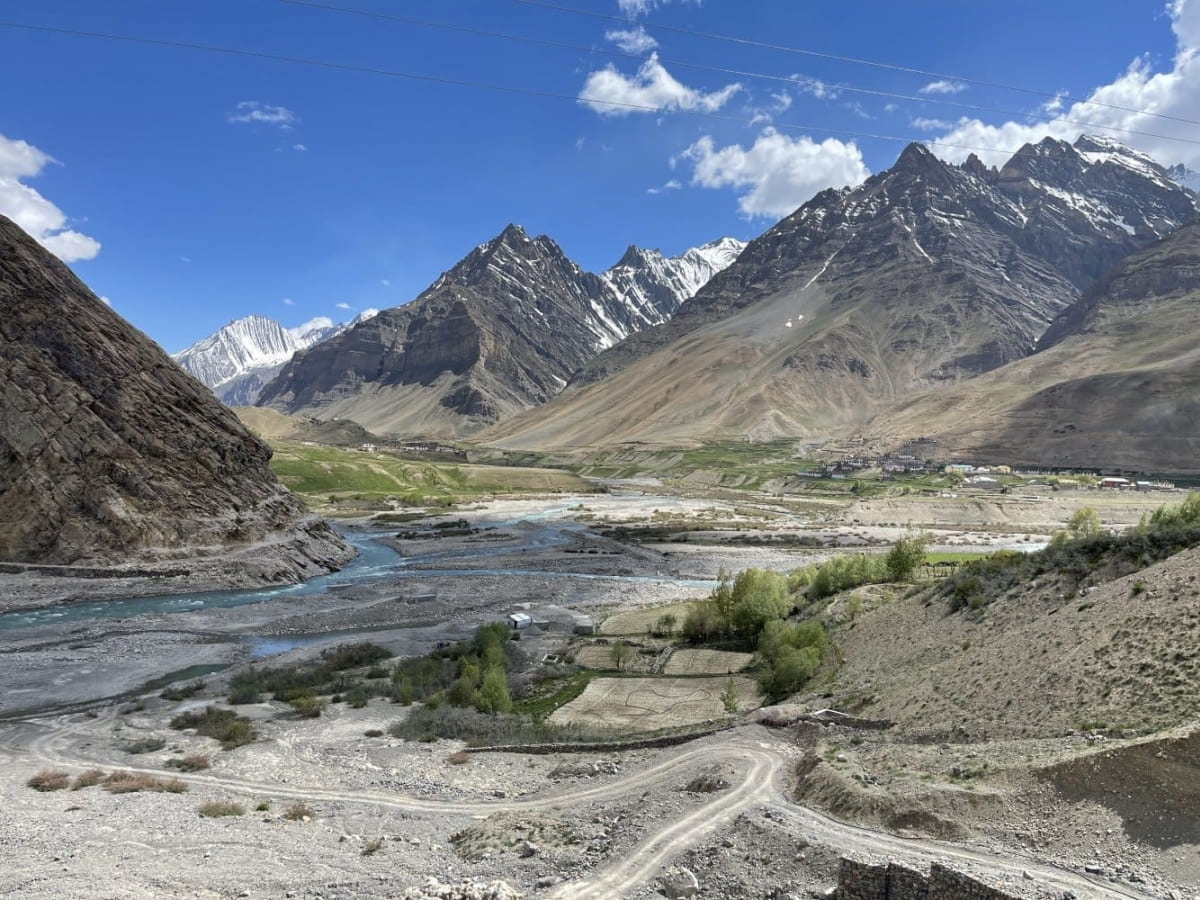
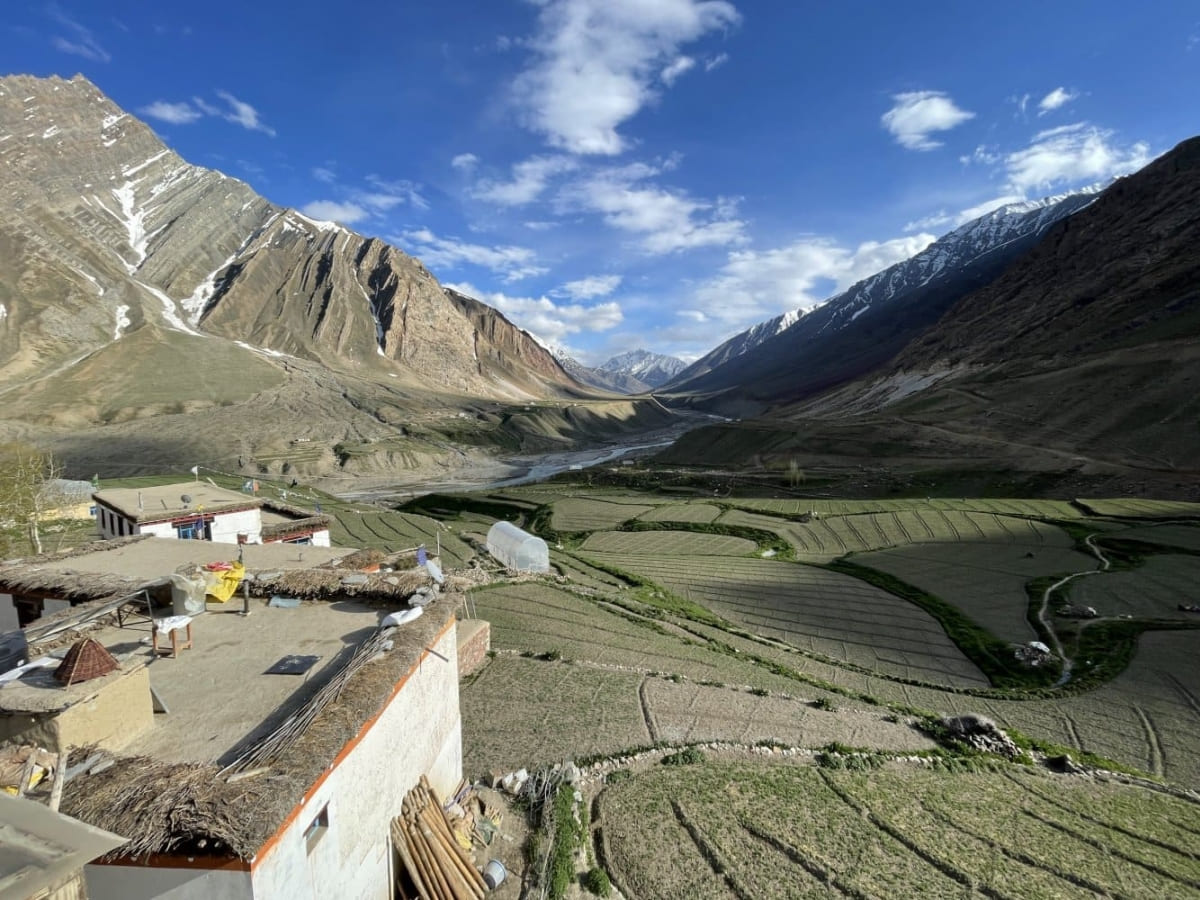
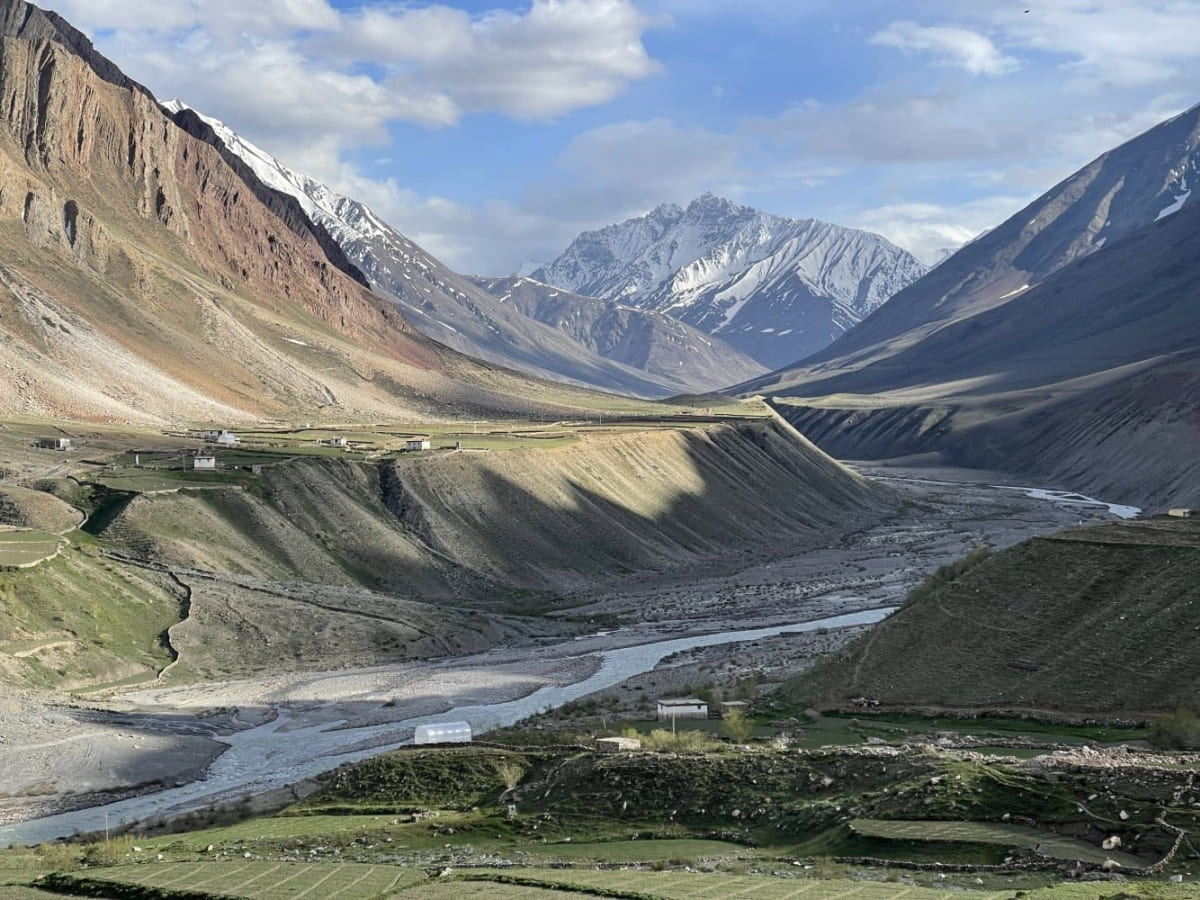
Explore Mikkim and the village of Sangnam. Visit the Kungri Monastery and then the charming hamlet of Mudh — the Pin Valley’s last motorable village.
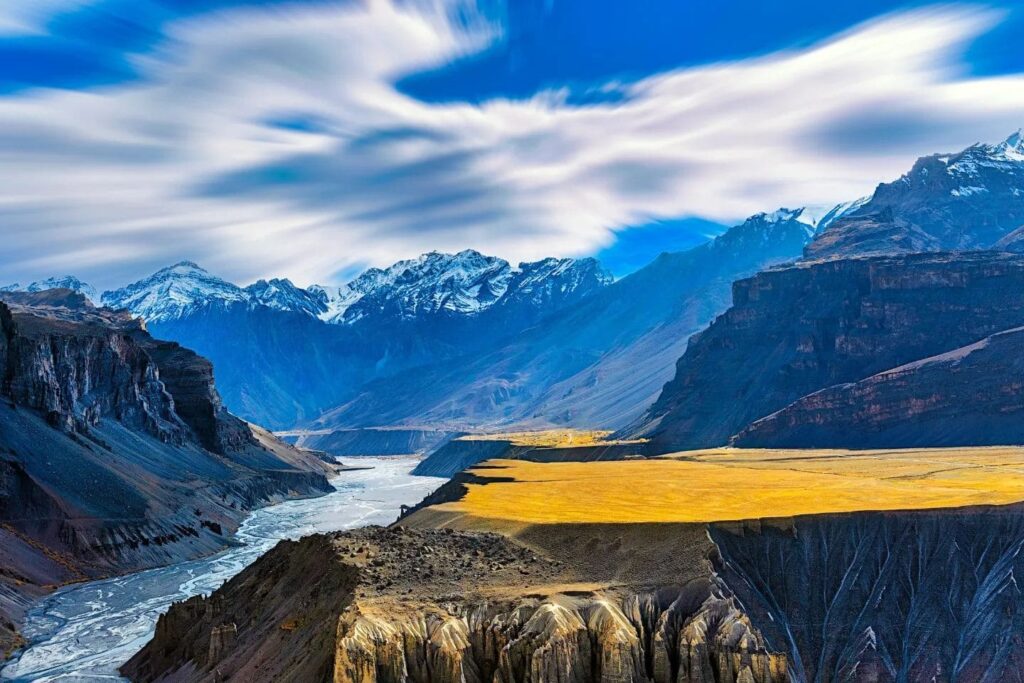
Stay at Mud for the night (12000 feet above sea level).
Day 8: Mud – Dhankar monastery – Kaza
Bucketlist Experiences
- Watch stone breaking ceremony, ritual and drama performance by Buchen (shaman of Spiti Himalaya) in Mud village of Pin Valley.
- See mud stupas built around the monastery.
- Sight rare Himalayan wildlife in Pin Valley National Park
- Visit Stupas and chortens, monastery museum and library.
- Photography on the beautiful banks of Pin River (right side tributary of Spiti river).
- Experience hospitality of people in Homestay.
- Taste local dishes and beverages in Homestay.
- See sangam (confluence) of a stream coming from Parvati Pass and Pin River and Sagnam village.
- Walk on Tailing village bridge. A wooden suspension bridge built over Pin river.
Sightseeing Day Trips
- Mud village walk.
Distance 50 km. 3 hours drivetime on Mud-Attargo bridge and NH505 (Attargo-Kaza road)
Drive to the eye-catching and imposing monastery of Dhankar. Perched on a riverfront cliff, Dhankar was the former capital of the Spiti Valley (when the valley was ruled by Nono kings).
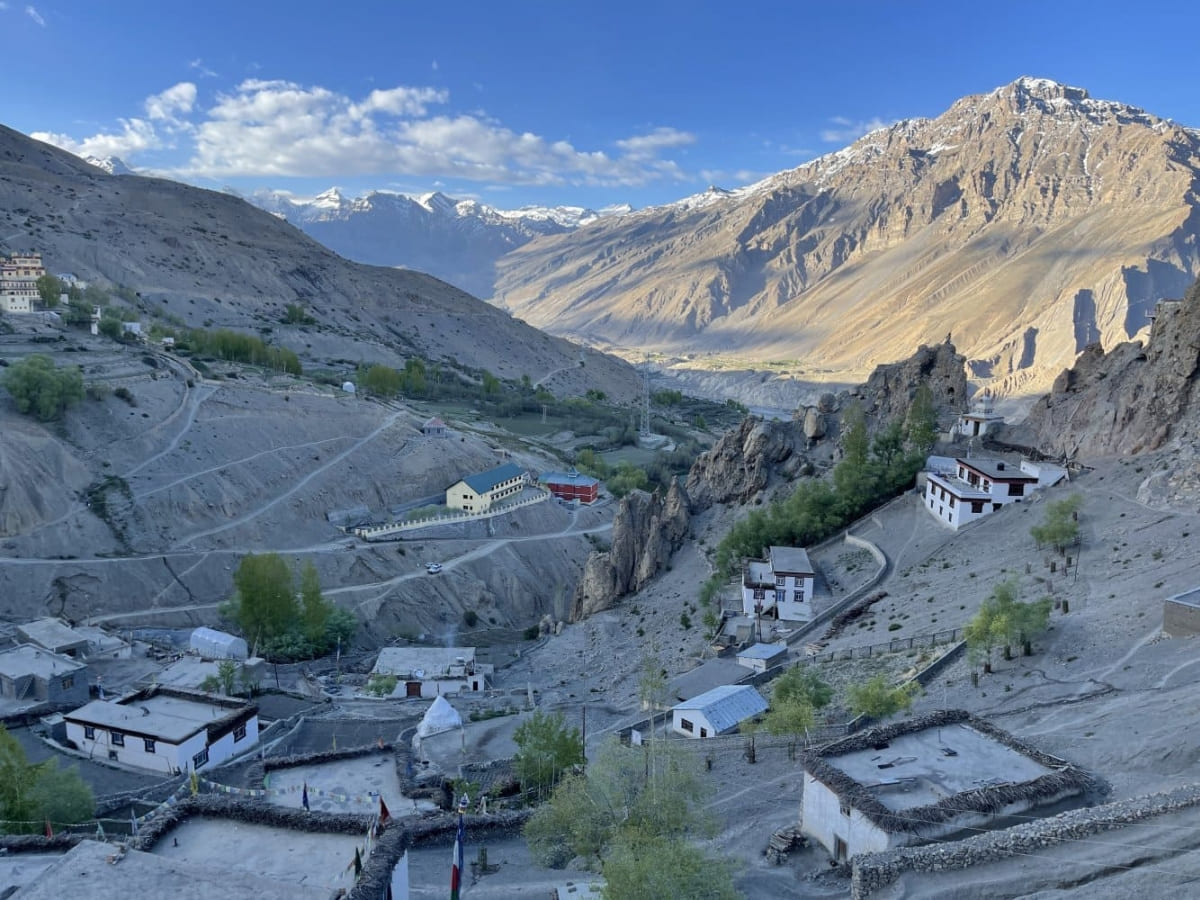
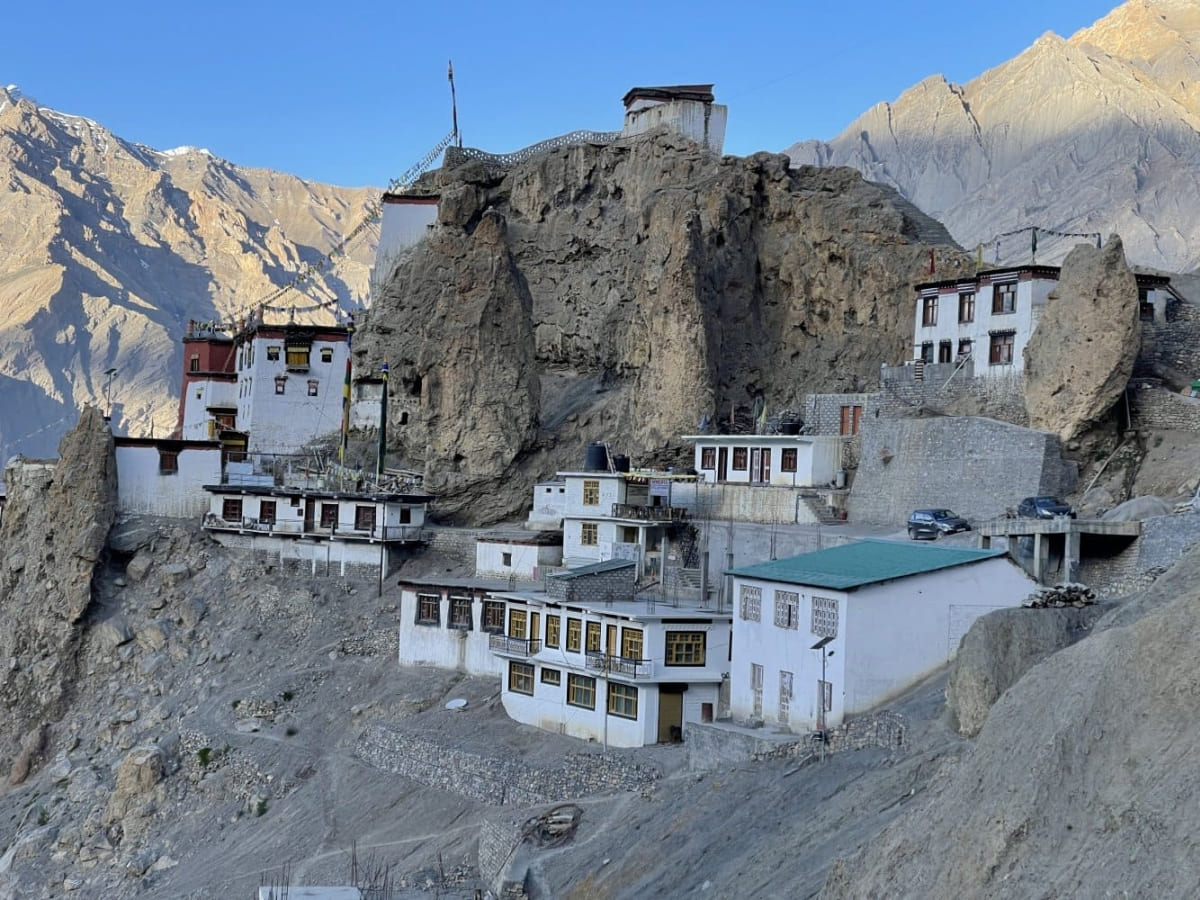
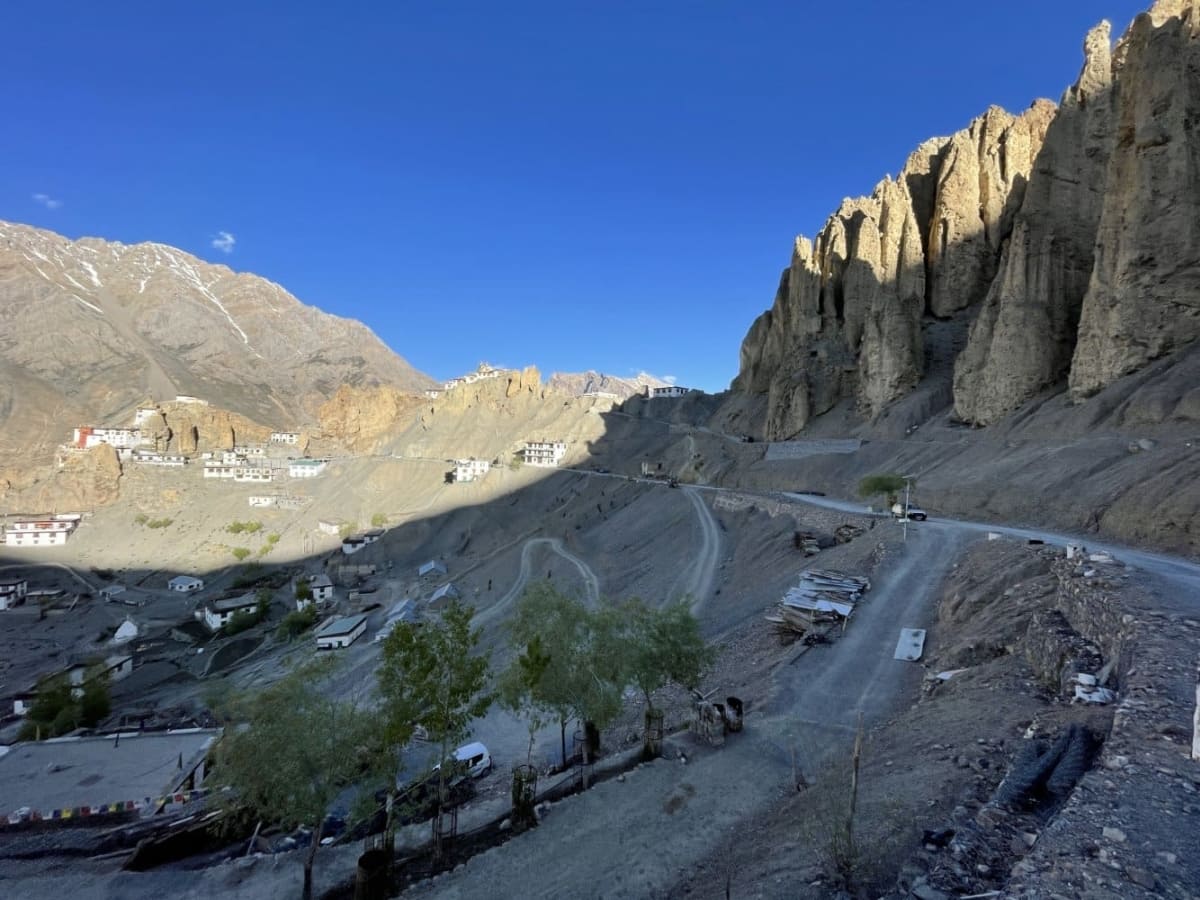
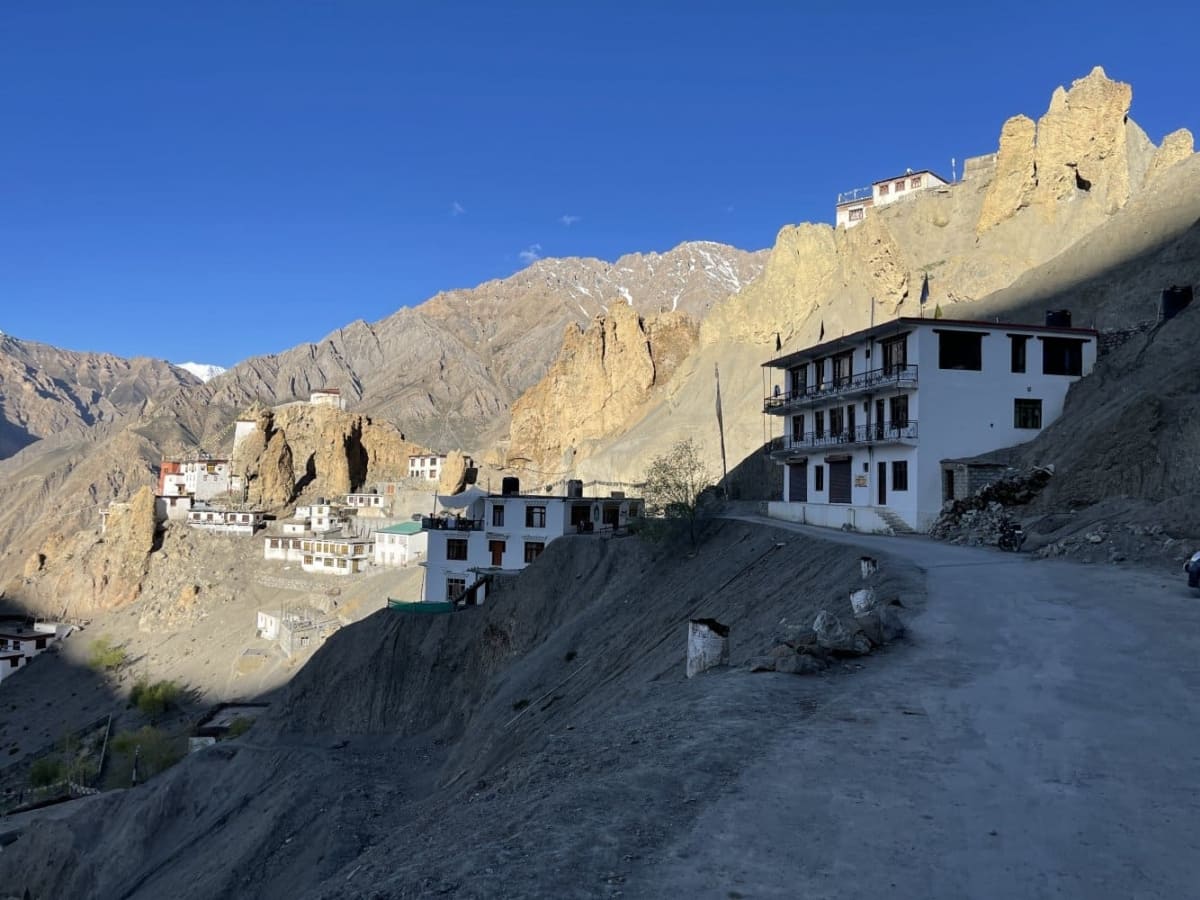
Overlooking the Spiti river, it offers panoramic views of the river valley. Visit one of the oldest Gompa in the Spiti Valley. Overnight at a hotel in Kaza.
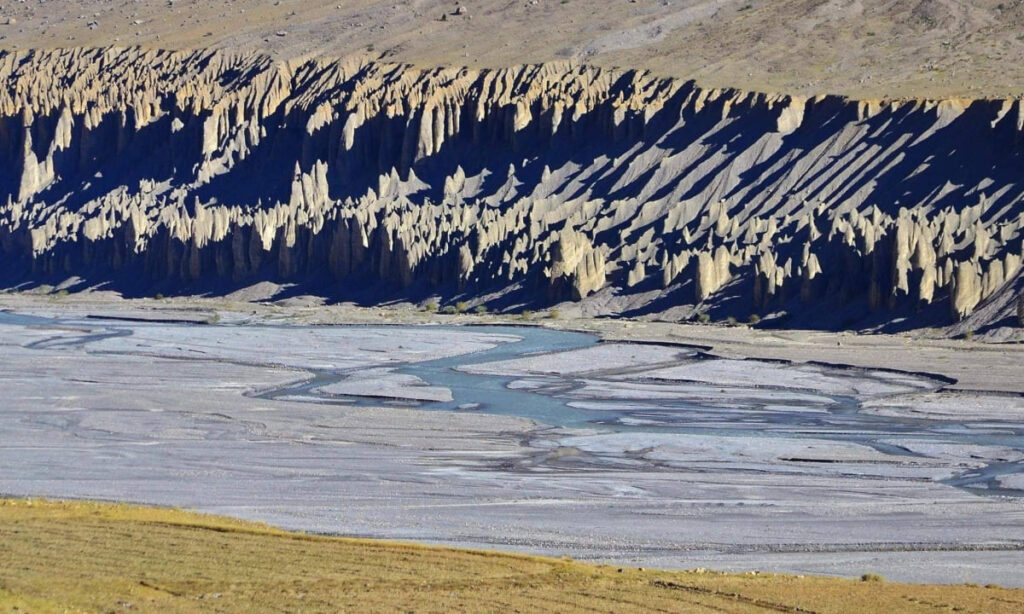
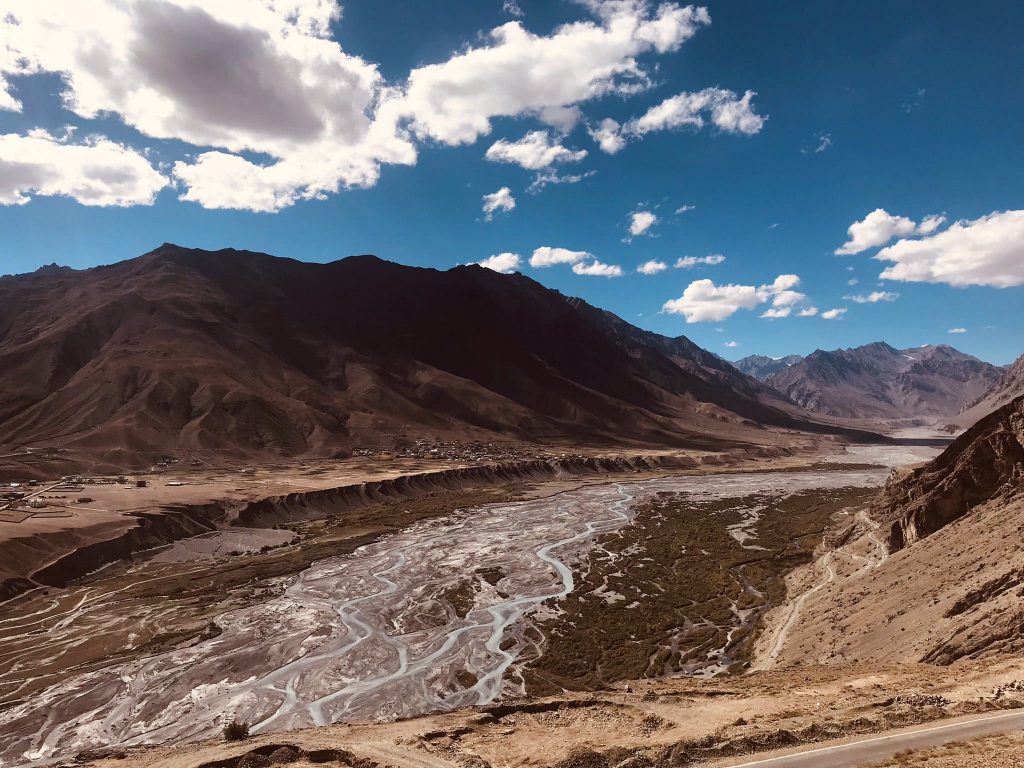
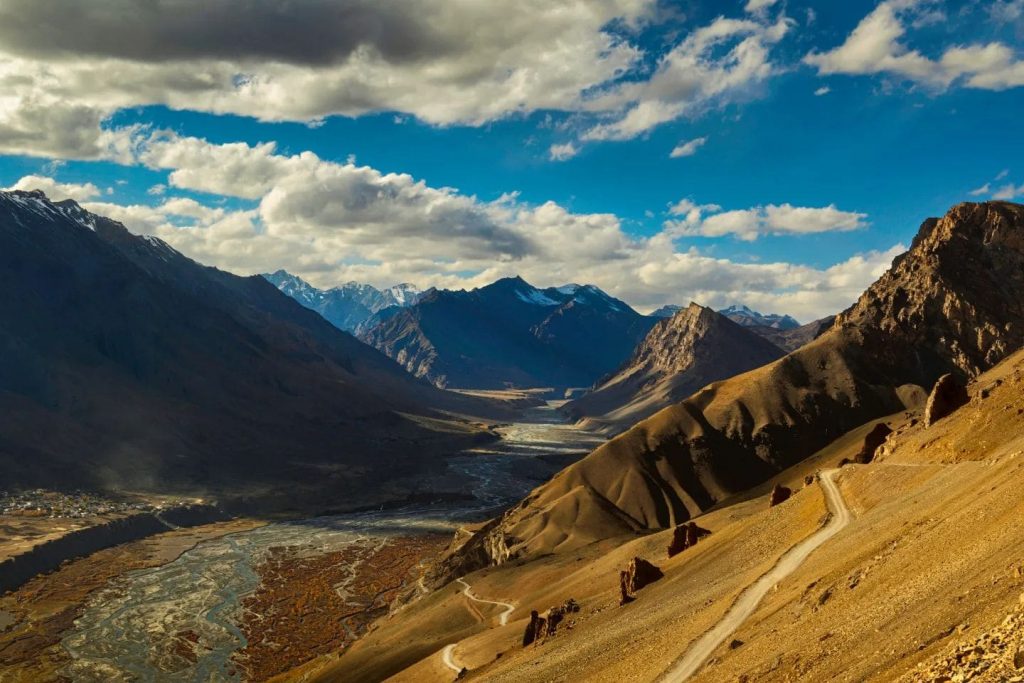
Day 9: Kaza-Hikkim-Lalung-Langza-Key-Kibber (5 – 6 hours drivetime)
Bucketlist Experiences
- Visit Komic (or Komik) village – the highest altitude village of Asia accessible by road.
- Send postcards to your friends and family from highest altitude post office in the world from Hikkim post office by India Post.
- Sight rare Himalayan wildlife in Pin Valley National Park
- Tangyud monastery of Komic.
- See Snow leopard mannequin made with snow leopard skin.
- Take drone shots of Buddha statue at Langza hill.
- Kibber village drive.
- Key (or Ki) monastery visit.
- See Cham dance of buddhist monks at Key monastery during the Guitor festival.
- See murals and Thangka paintings inside the Ki monastery complex.
- Take drone shot from Chicham suspension bridge.
Sightseeing Day Trips
- Kaza market visit.
- Kaza monastery visit.
- Key-Kibber-Langza drive.
- Komic and Hikkim village visit.
- Chicham village visit.
The highest village in Asia, Komik, which literally translates to ‘eye of a snowcock’, is situated at a height of 4513 meters. Later, we drive to Hikkim where we visit the world’s highest post office in the world. After sending out a postcard, we drive to Langza.
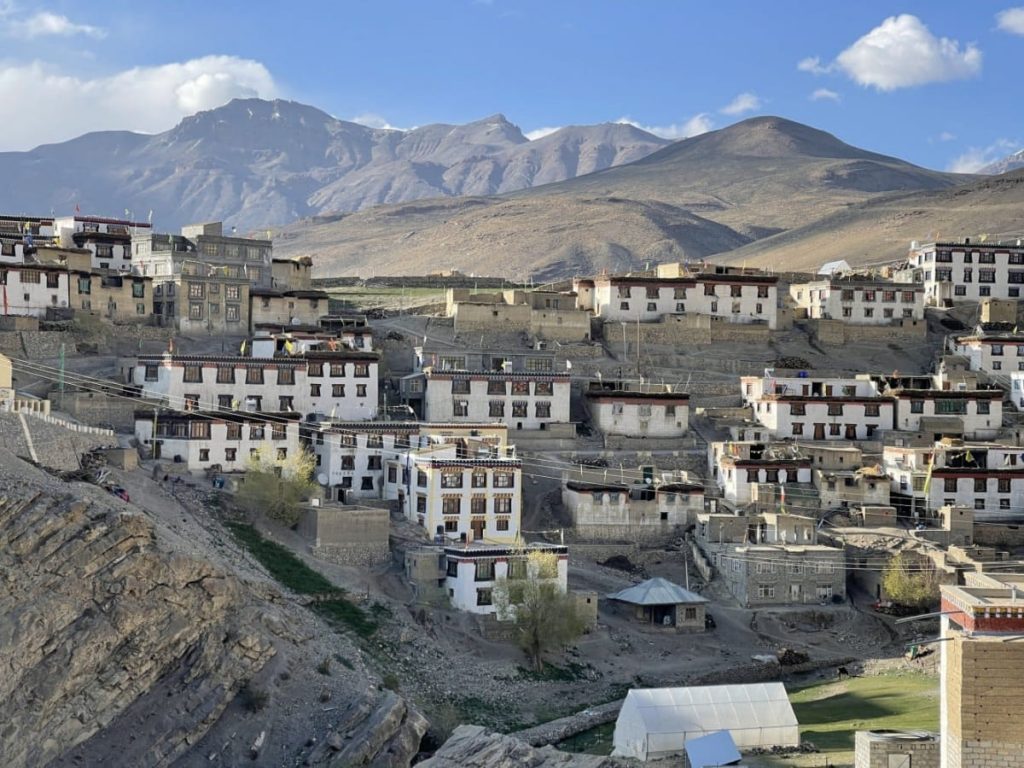
Once you are here, you can walk around the village and visit the ancient Lang (Temple) which is estimated to be around 1000 years old. Visit to Key monastery. Overnight stay at Cherring’s homestay, Kibber.
Kibber is one of the two (other is Korzok) villages from where the trekkers start their quest for Parang La pass.
Raacho Trekkers
Day 10: Drive from Kaza to Kunzum top (4551 meter) & camp at Chandertal Lake (4270 meter)
Bucketlist experiences
- Camping experience near Chandratal Lake.
- Explore small glacier lakes above Chandratal.
- Experience view of Spiti and Lahaul valley from 4551 meters high Kunzum-La pass.
Distance 102 km. 4 hours drivetime on Kaza-Kuzum-Batal road (NH505) and Batal-Chandratal lake connecting road.
Drive to one of the most photogenic places in Spiti Valley – the Chandra Tal Lake. Before that, we pass through the high altitude pass of Kunzum La. Stop by at the stupa and pay tribute to the local goddess, “Kuzum Mata” as she’s known.
At 15,000 feet above sea-level, the Kunzum Pass connects Kullu and Lahaul to the Spiti Valley. Live your dream of camping comfortably in the Himalayas as you spend your evening gazing at the Milky Way and the millions of stars on a clear night. Overnight at a camp 2 km away from Chandratal Lake.
Day 11: Chandratal lake to Manali drive via Atal tunnel
Bucketlist experiences
- Experience savoury food at Chacha-Chachi dhaba at Batal.
- Crossing numerous streams and nallahs en route.
- Drive through Atal Tunnel – the engineering marvel by BRO (Border Road Organisation.
Distance 110 km. 3 hours drivetime on Batal-Atal Tunnel (NH505) and Atal tunnel-Manali road.
On the 10th day of this Spiti Valley tour, drive from Chandratal Lake towards Manali. Drive through the engineering marvel i.e. Atal tunnel and drive to Manali to end our breath-taking Spiti Valley sojourn. Overnight at a hotel in Manali.
Day 12. Manali to Chandigarh.
After breakfast, enjoy some brilliant views of the Himalayas from your hotel in Manali. Proceed to Chandigarh after breakfast. Drop off at Chandigarh airport in the afternoon. The Spiti circuit tour ends here.
₹ Cost Inclusions in Spiti Circuit Trip
- All arrangements for overnight stays during the trip.
- All food expenses.
- Driver, fuel and toll charges.
- Food will usually consist of morning breakfast, lunch, evening high tea and dinner.
- Special trained certified guides trained for emergency situations.
- Local guides and workers with in-depth knowledge about the local area.
- It will be a cultural and traditional experience as all stays will be mostly in villages.
- Inner line permits and arrangements en route will be arranged by the operator.
- All stays and lodging on a twin sharing basis shall be provided.
Exclusions
- Any kind of personal expenses.
- Camera fees or any other costs arising out of unforeseen circumstances and situation beyond our control.
- Anything not mentioned in the inclusion section.
🧭 Places to visit en route Spiti valley
Narkanda
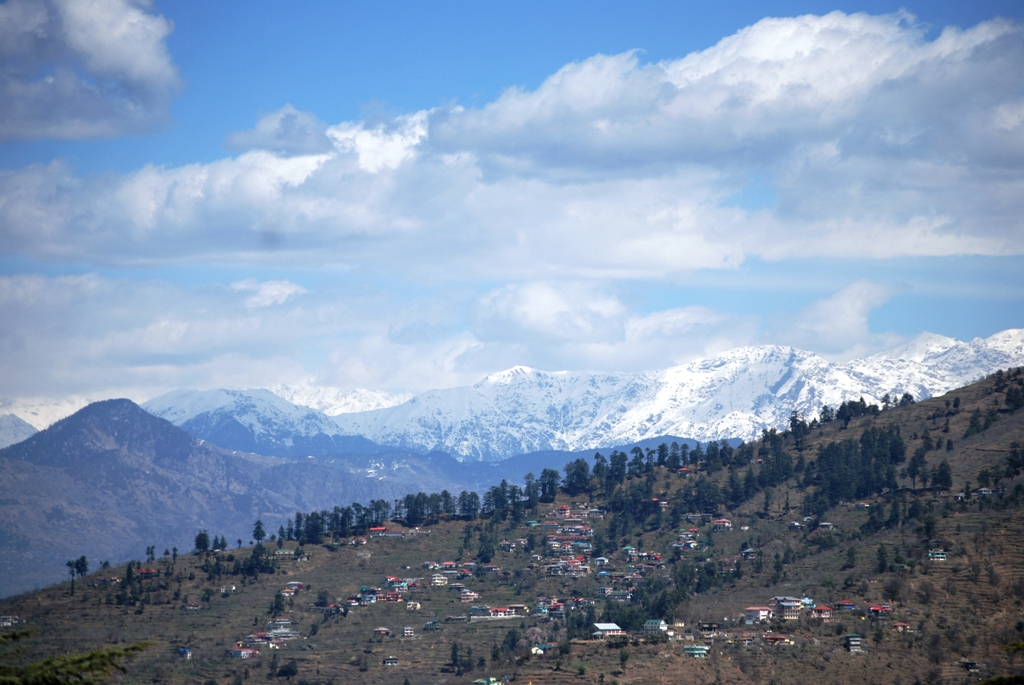
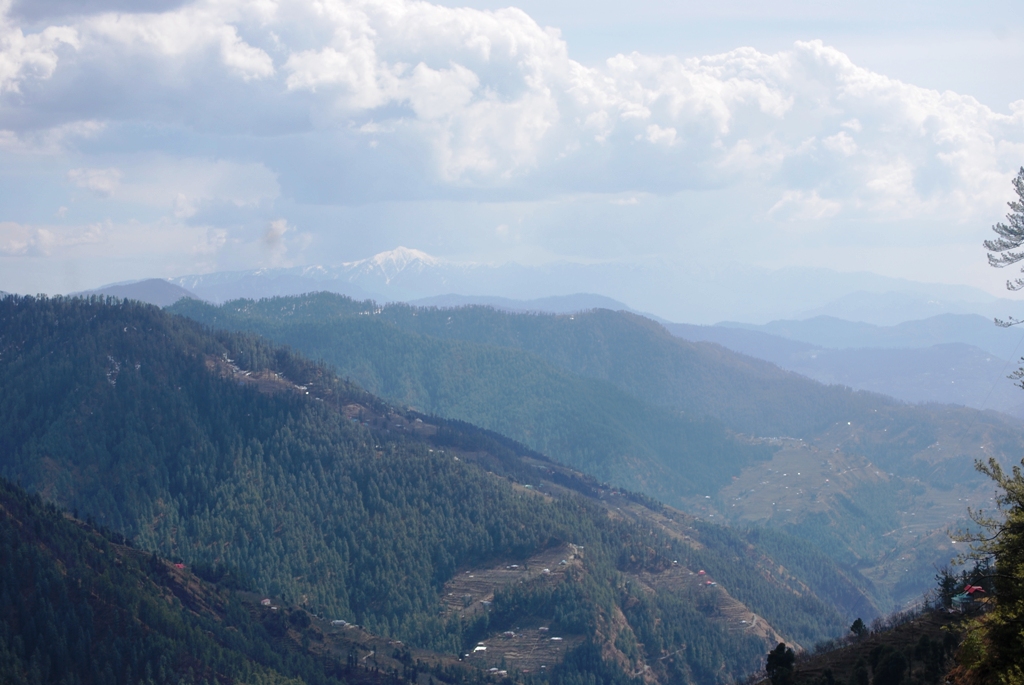
Narkanda is a small town in the Shimla district of Himachal Pradesh. It is located at an altitude of 2750 meters on the Hindustan-Tibet Road (NH 05). Surrounded by the forest Kinnaur – Garhwal Himalayan Range. The experience of a panormic view from the Hatu top is not to be missed.
Padam Palace, Rampur Bushahr
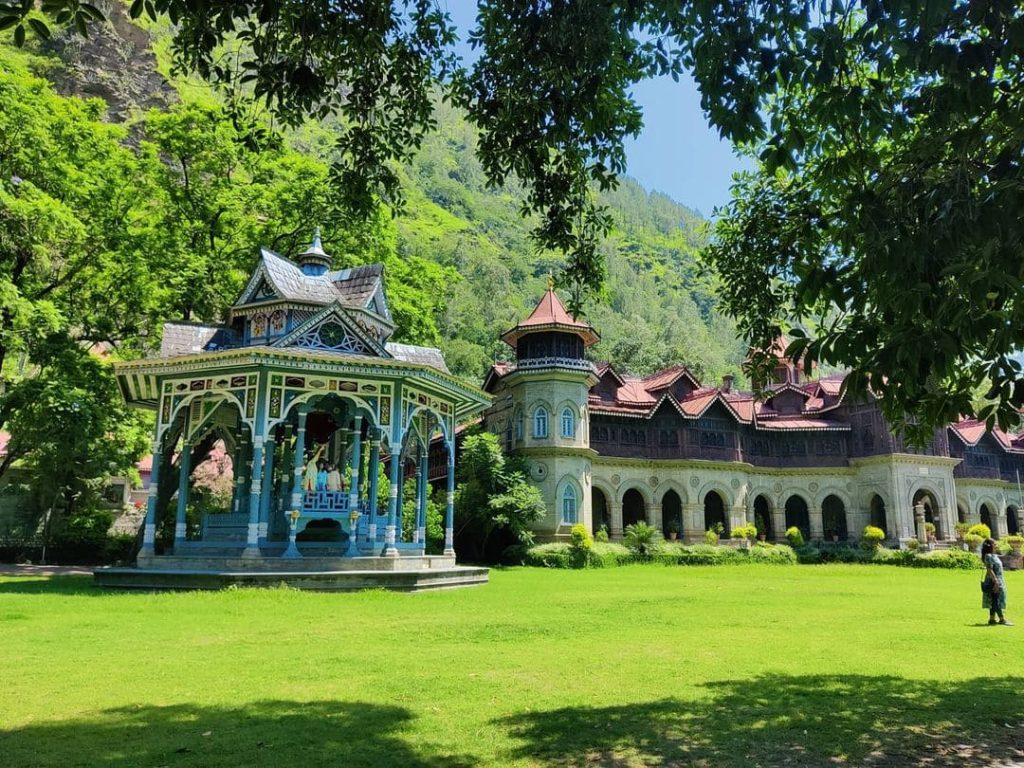
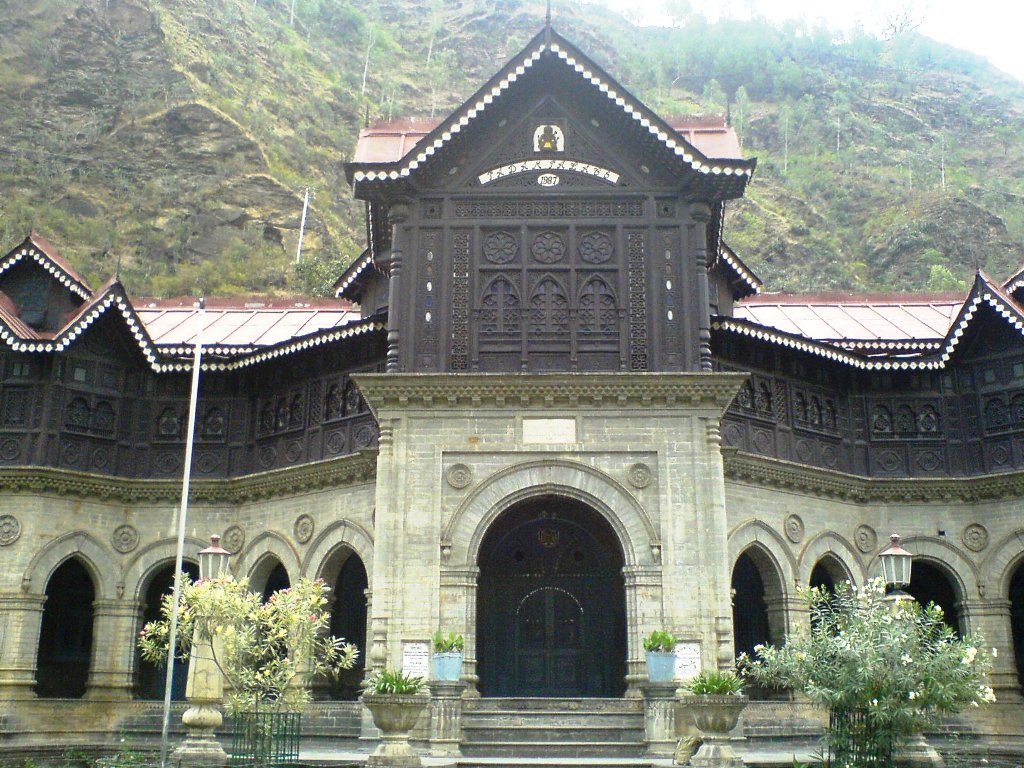
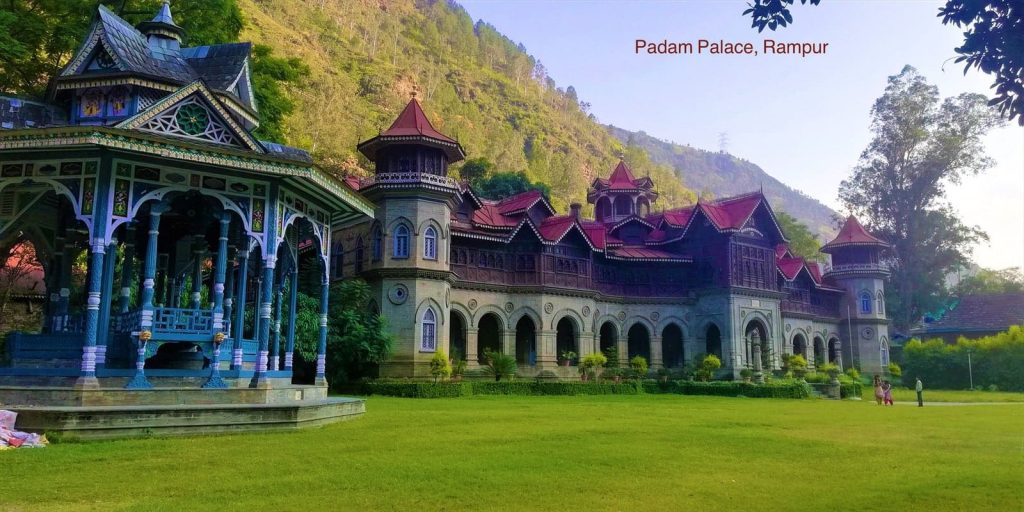
The palace of erstwhile Bushahr princely state is built in neo-gothic architecture. Built between 1919 and 1925 for the Raja of Bushehr, the main building is still private, but one section is now the Nau Nabh Hotel, and the garden is open to visitors. From here you can admire the facade’s stone arches, carved-wood upper storey, peaked gables, and turreted towers. In front is a remarkable multi-gabled bandstand carved with peacock figures.
Sarahan
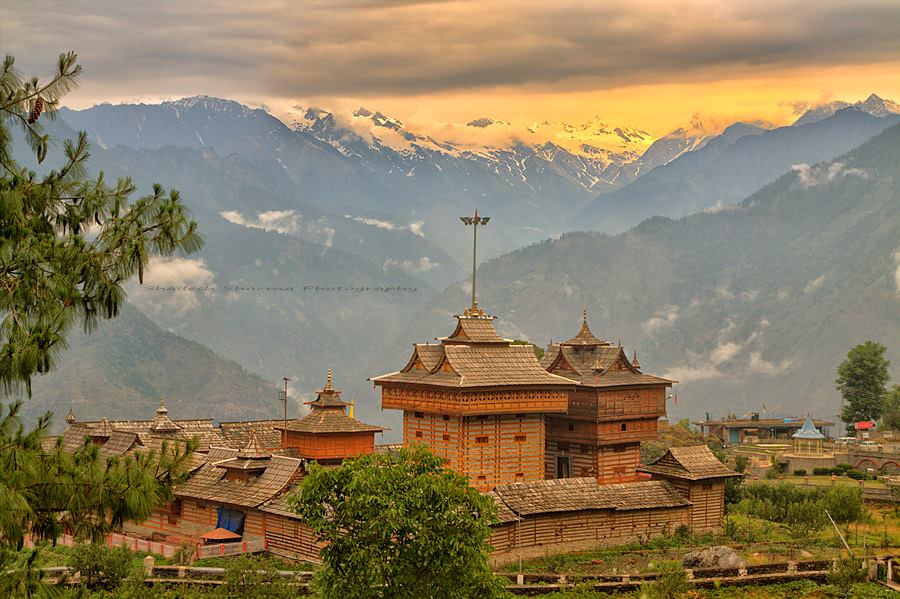
Sarahan is a small village near Jeori town. It is the site of the Bhimakali Temple, dedicated to the goddess Bhimakali, the presiding deity of the rulers of the former Bushahr State. The temple is situated about 170 kilometers from Shimla and 12 kilometers from Jeori town.
Sarahan Pheasantry
Also known as Jajurana Bird Sanctuary, this park is worth a visit. It hosts Jajurana, the state bird of Himachal Pradesh and a few other rare birds. Please note that the sanctuary remains closed from July to September for bird mating season. If you are traveling in any month apart from these three, a visit is highly recommended.
Baspa valley of Kinnaur
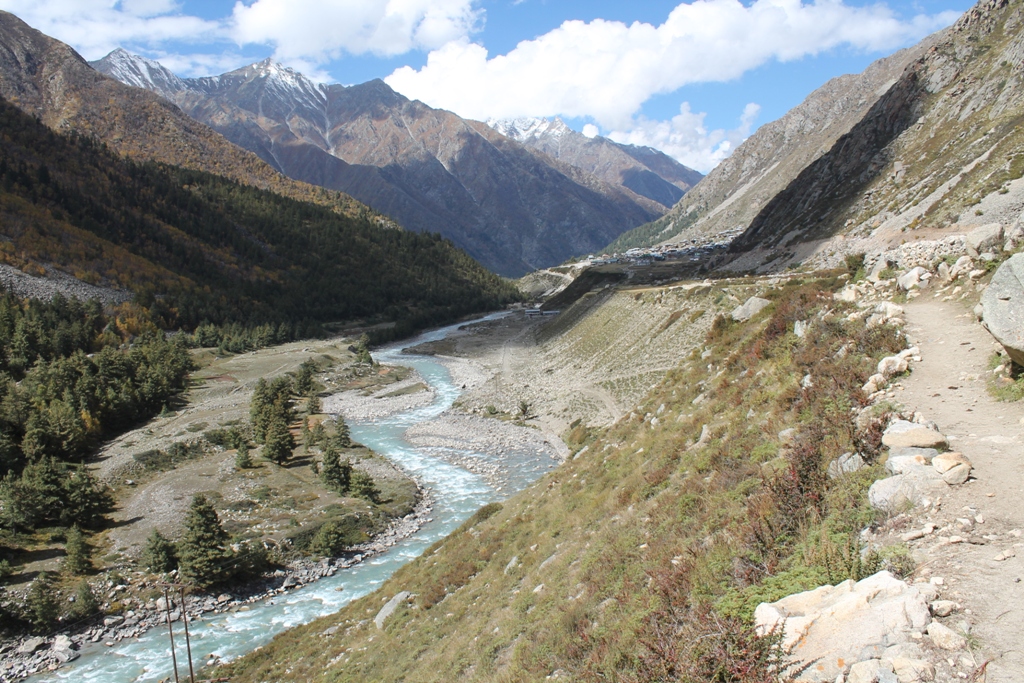
Bordering along western Himalaya with Tibet and Garhwal, the Baspa valley of Kinnaur has been open to visitors since the early nineties. The valley got its name from the Baspa river which originates from Chung Sakhago pass and meanders for around 30 km before meeting Satluj on its left bank near Karcham. Unlike the Spiti valley and Hangrang region of Kinnaur, the Baspa valley is a green paradise in largely barren mountains.
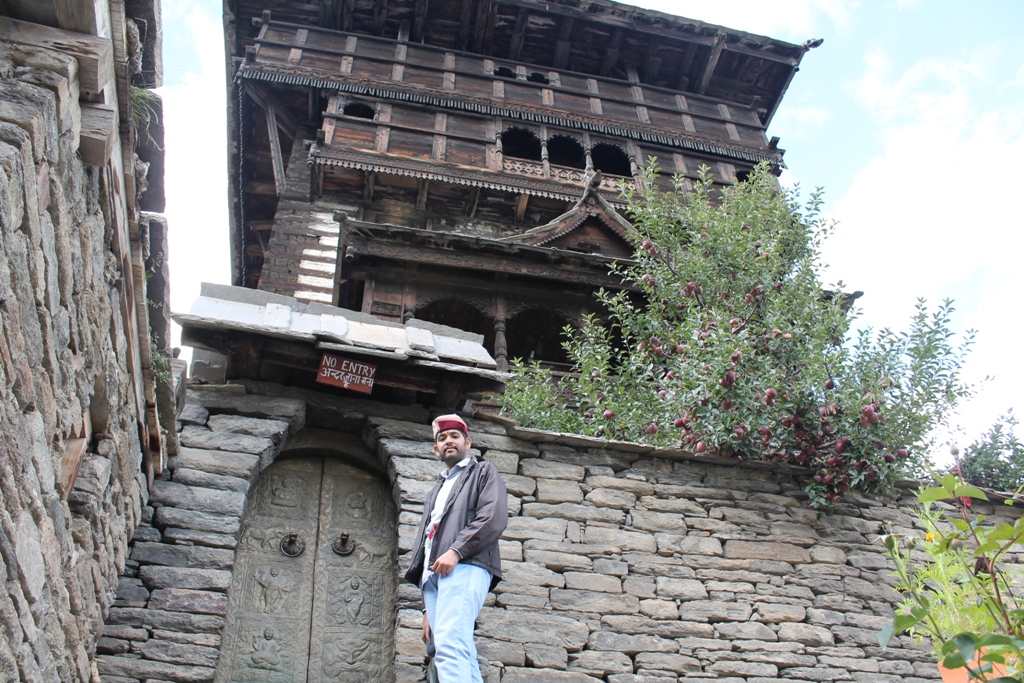
Baspa valley or Sangla valley is known for fruit-laden orchards, cedar-covered slopes and flower crusted meadows. Bhojpatra tree is abundantly found in the Chitkul region. A land of blue skies, buzzing Baspa river, soaring peaks, deep valleys, apple orchards, and syncretic culture — Baspa valley a place for people who are seeking genuine peace and soul-calming solitude far, far from the madding crowd. The fort of Kamru is another landmark in Baspa valley.
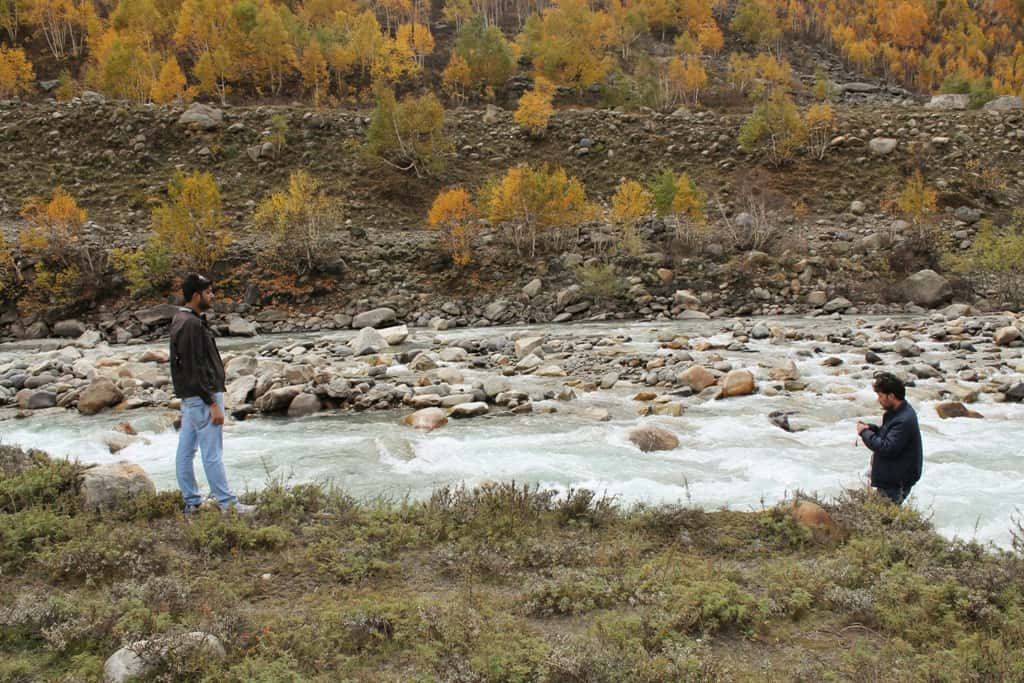
Chitkul, Rackcham, Sangla, Kamru and Chansu villages should be on your bucket list if you are visiting Kinnaur for the first time.
Kalpa Village
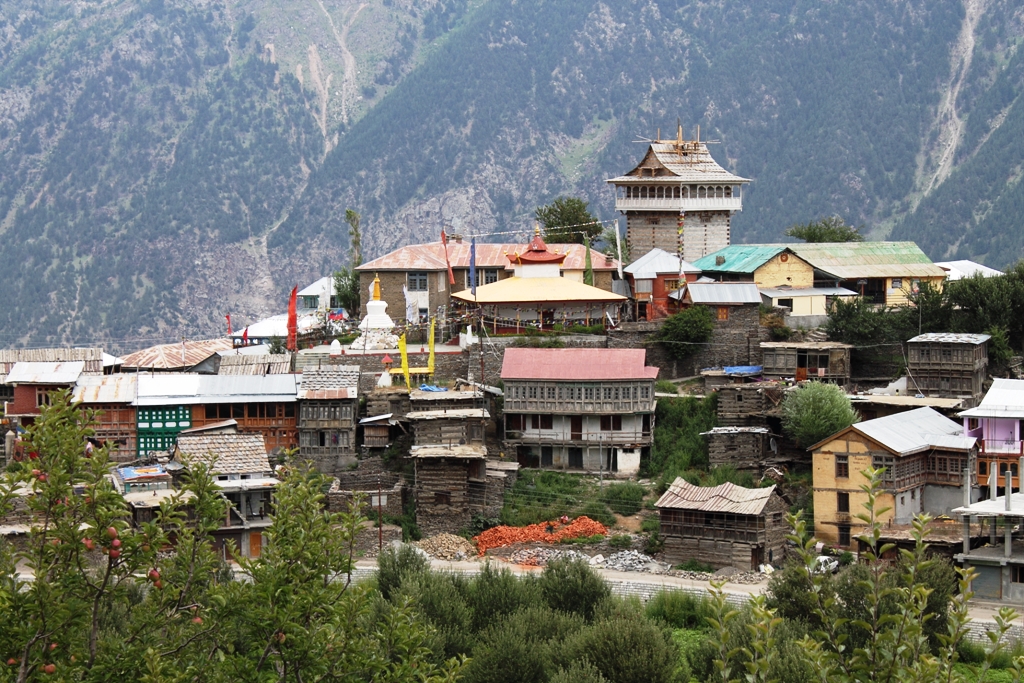
A small village about 10 kilometers from district headquarters Reckong Peo, known for the magnificent view of Kinner Kailash peaks. The focal point is Chini village and surrounding places like Kalpa Narayanas temple and Buddhist monastery.
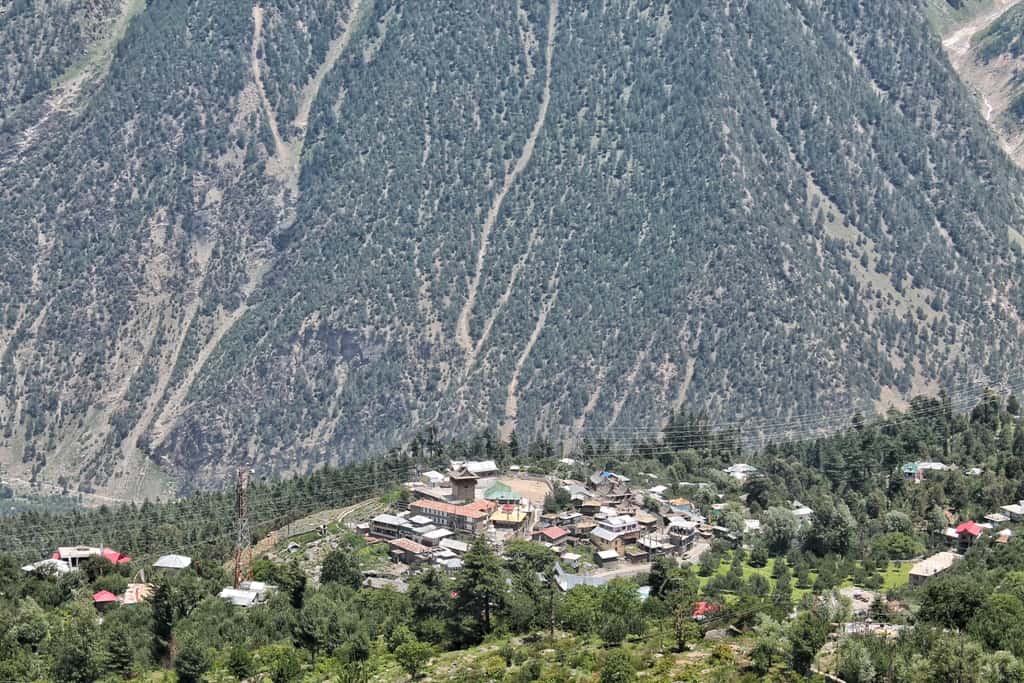
Kalpa will probably be the last town where your phone will work flawlessly, no matter which network you are on. As you cross Kalpa and continue towards Pooh, your phone services will be a come and go before it completely dies. Only the BSNL network works in the Spiti & Lahaul valley.
Reo Purgyil peak view
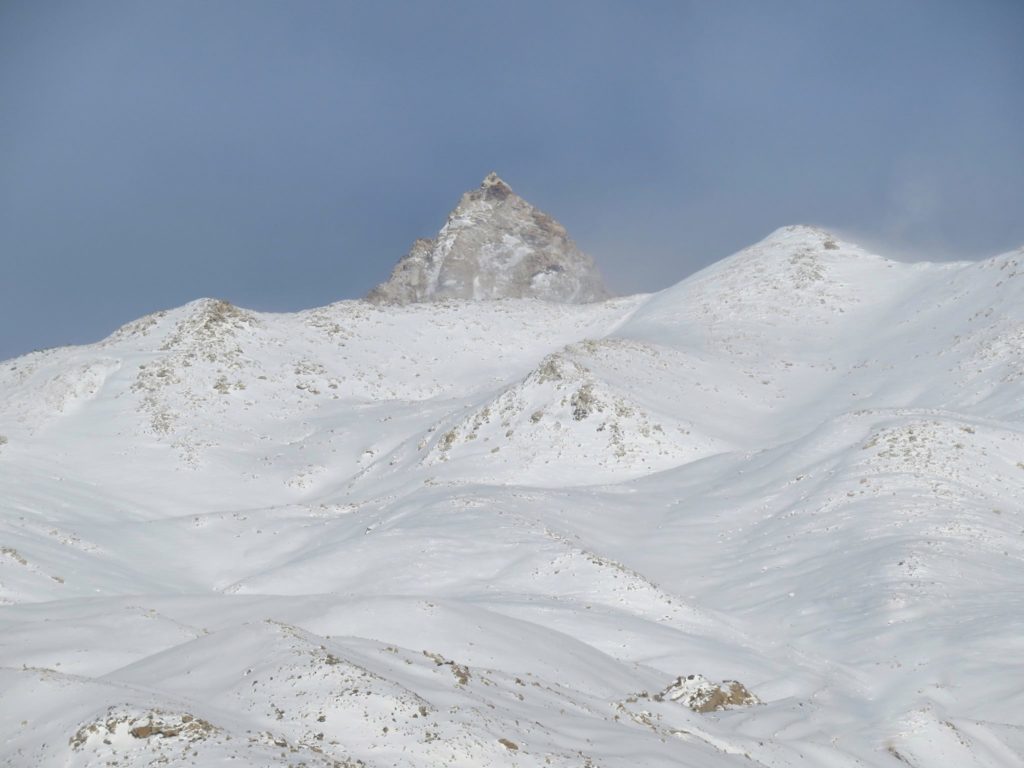
At an altitude of 6816m, it is the highest peak of the state of Himachal Pradesh. You can get a good view of the peak from Khab Bridge if the weather is clear. If not from Khab Bridge, you will have to go up to Namgia or Tashigang village to get a clear view. Nako Village is located on the slopes of this mountain.
Nako Lake And Monastery
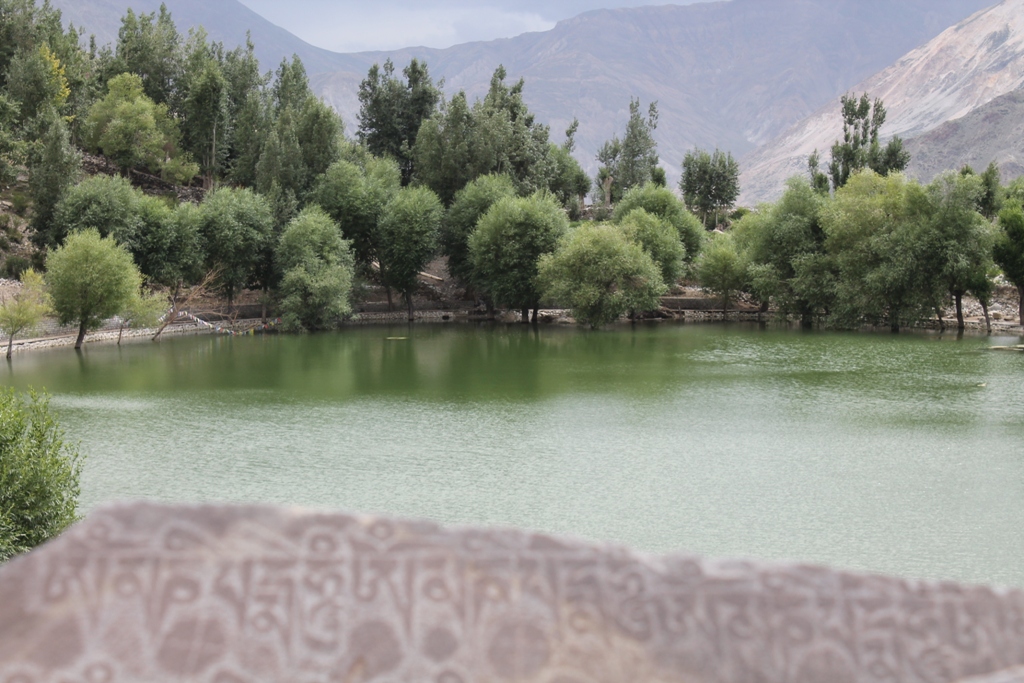
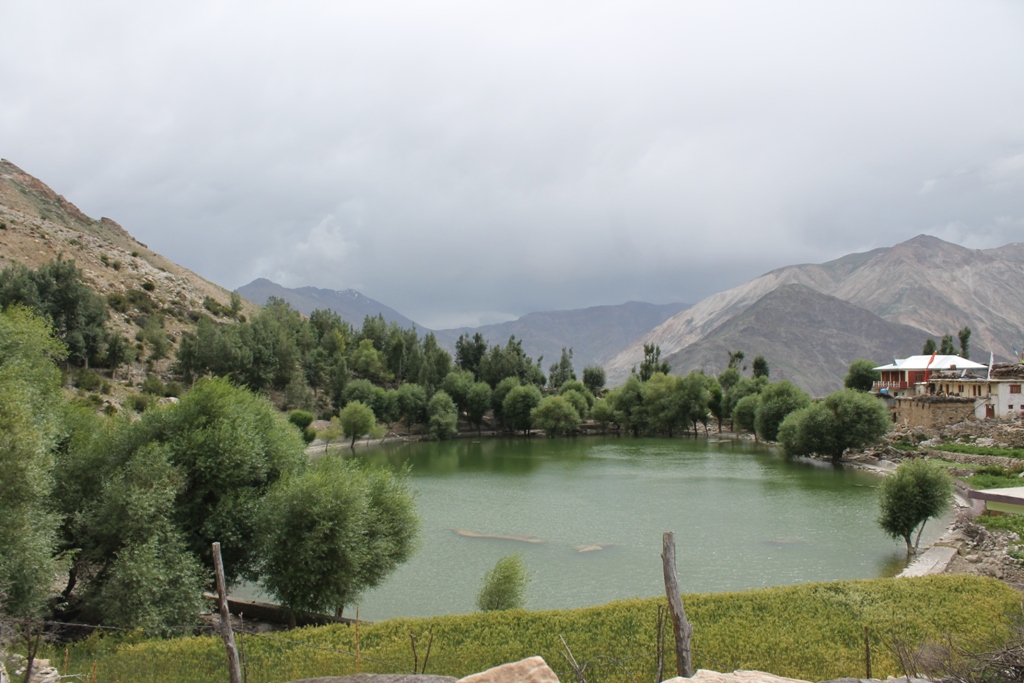
A small man-made lake in the village of Nako. It is not much to look at during the daytime but try some photography around the lake at either dusk or dawn and you will be able to get some good shots.
Nako Monastery is an 11th-century ancient monastery located in the village of Nako. It was built by Buddhist Mahaguru Rinchen Zangpo who translated many Sanskrit Buddhist texts into Tibetan. He founded around 100 monasteries in western Tibet including Tabo monastery.
Tabo Monastery
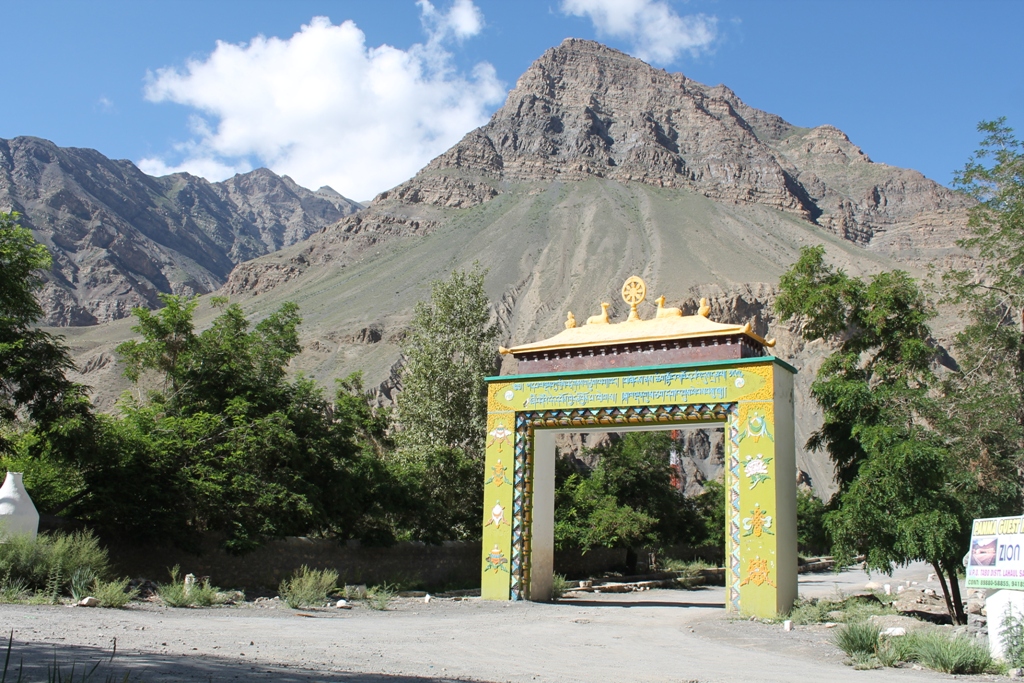
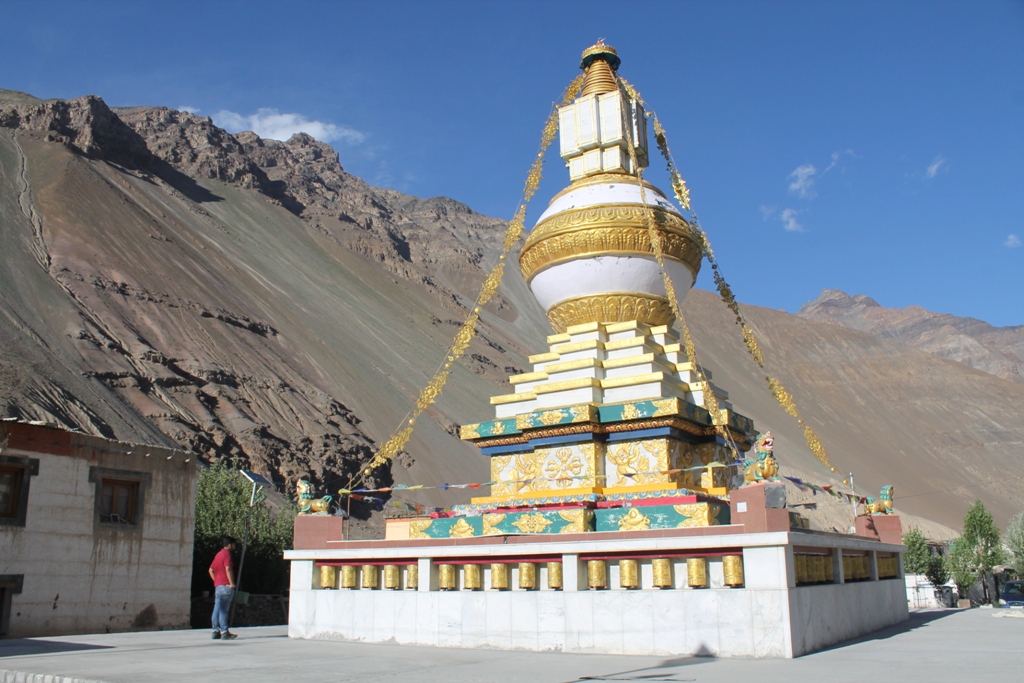
Tabo Monastery: An ancient monastery believed to be over a thousand years old and one of the holiest. Founded in 996 AD it is also known as Ajanta of the Himalayas. Many priceless collections of scroll paintings, manuscripts, well-preserved statues, frescoes, and extensive murals can be found here.
Dhankar Monastery
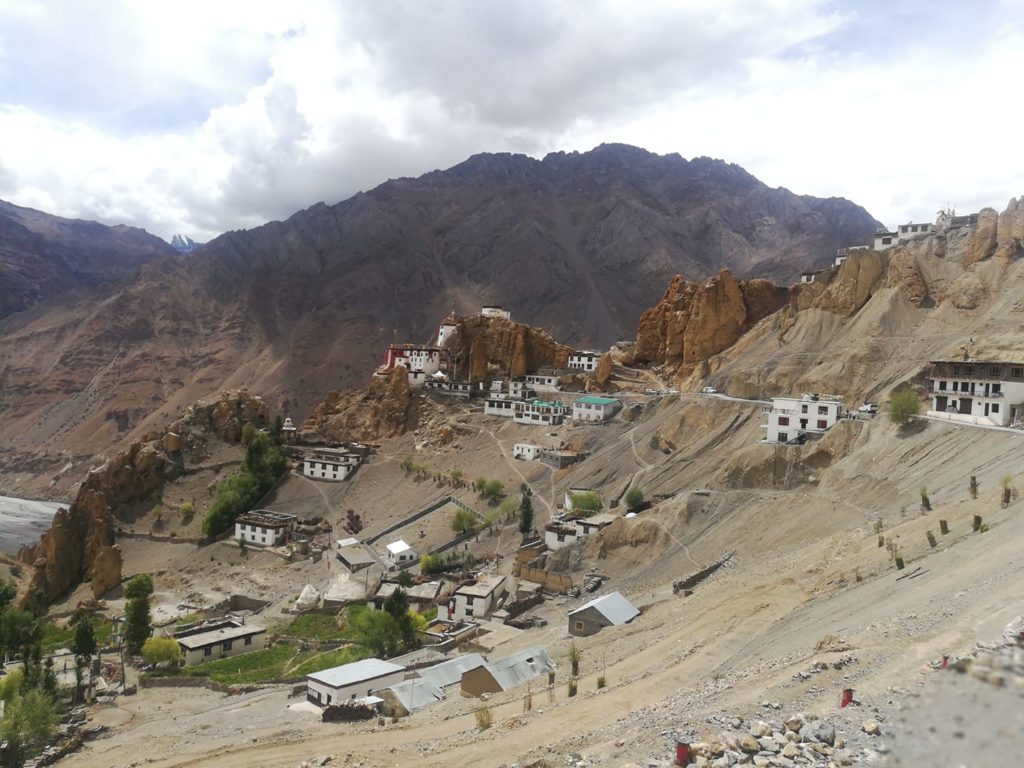
Also known as Dhangkar Gompa, it is an ancient monastery built on a 1000 foot high cliff overlooking the confluence of Spiti and Pin Rivers. Apart from its heritage, this monastery is also famous for its spectacular setting. “Dhang” means cliff and “Kar” means fort, hence the literal name of the place is “Fort on a cliff”.
Key Monastery
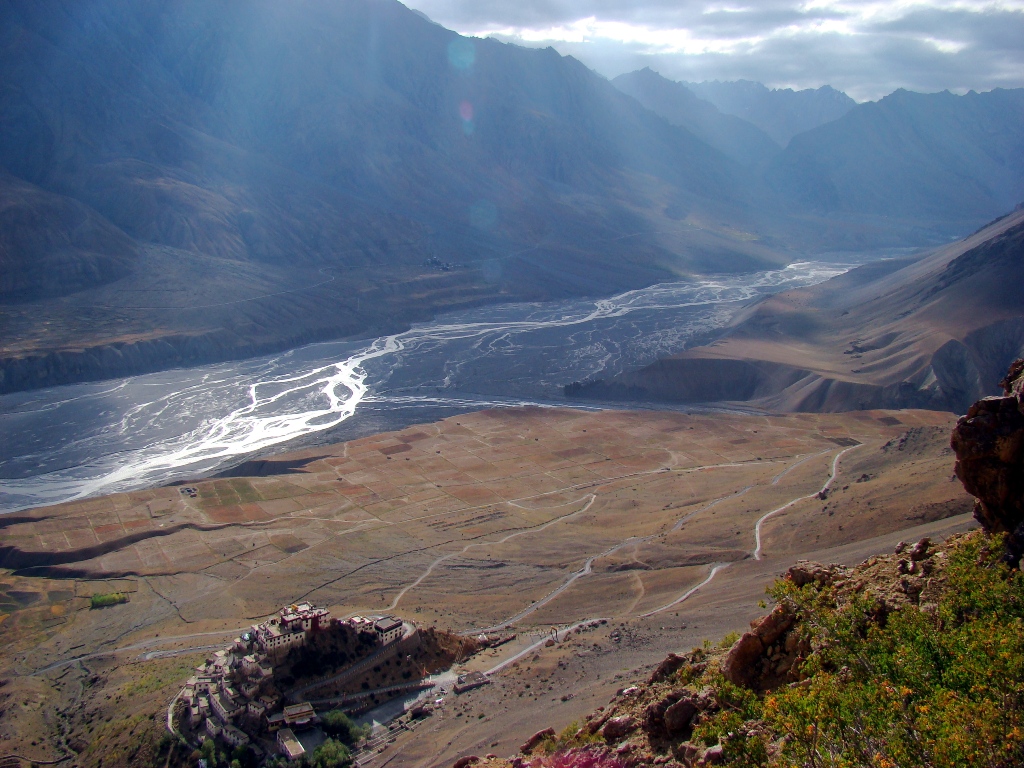
The Key monastery.
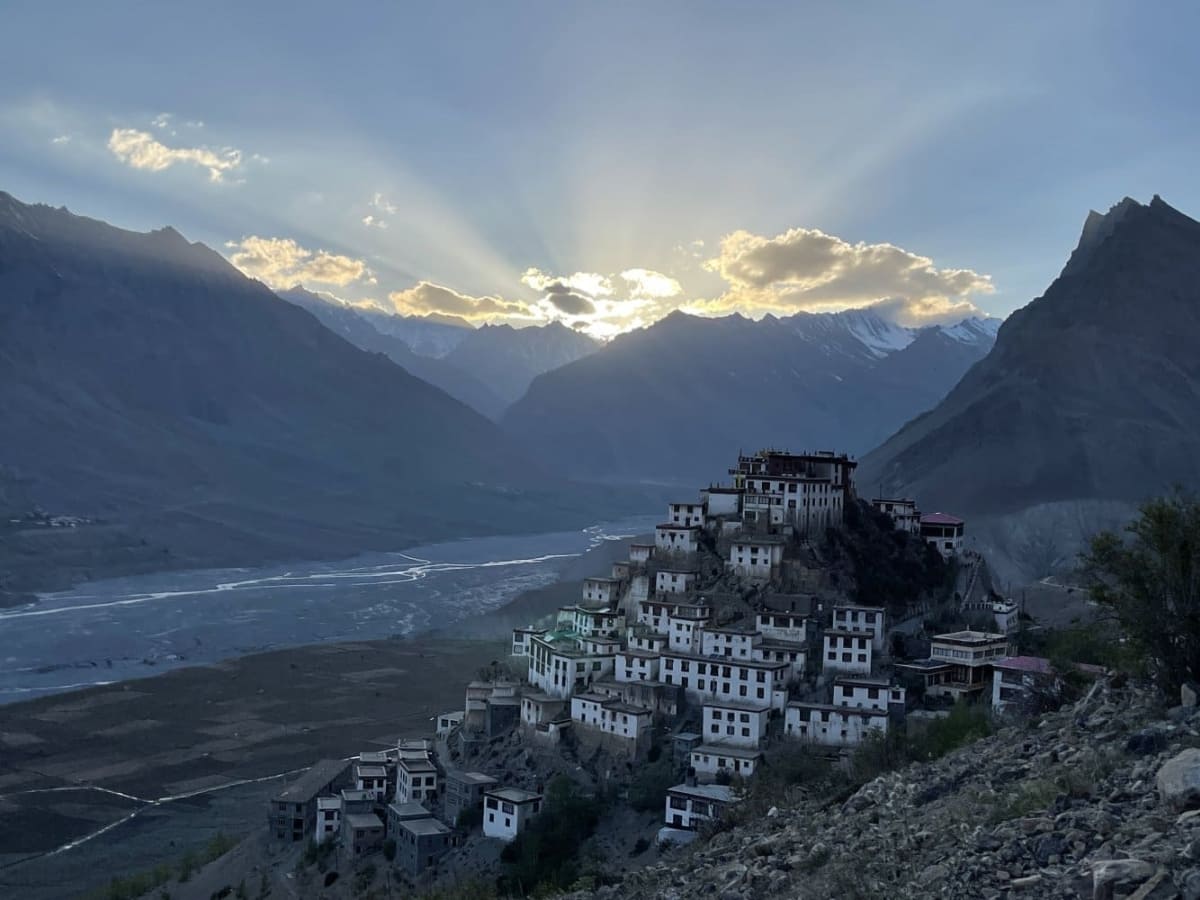
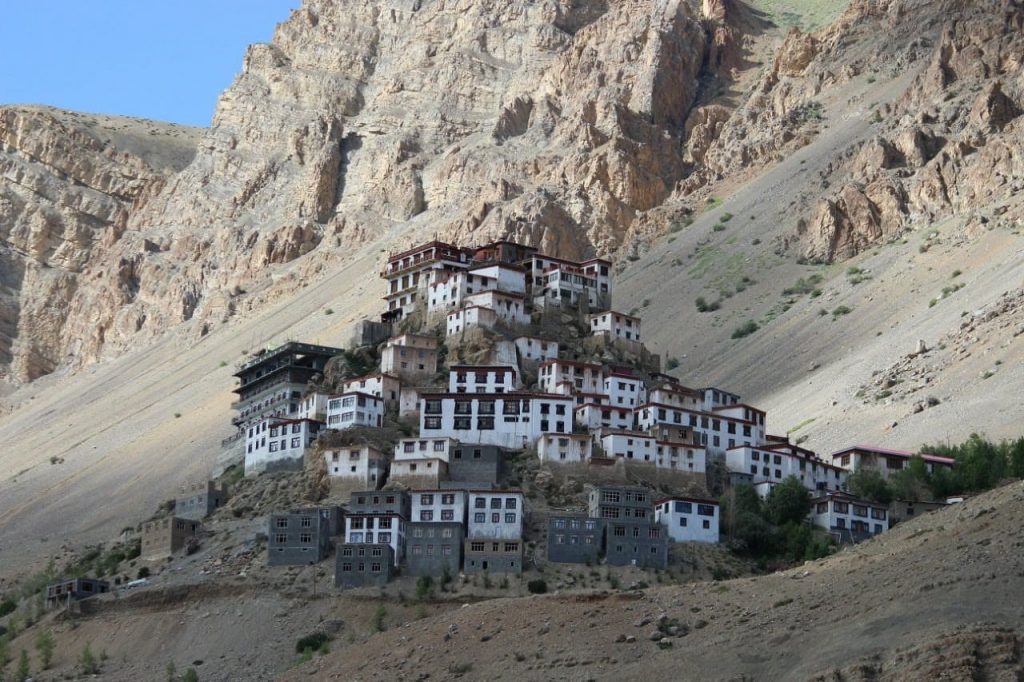
Also known as Kye or Ki Gompa, it is one of the largest monasteries in Spiti valley that also serves as a training center for Lamas. It is believed to be over a thousand years old and has a vast collection of ancient murals and books.
Kibber Wildlife Sanctuary
It was established in 1992, Kibber is India’s only wildlife sanctuary in cold desert and is home to several rare animals like Ibex, Blue Sheep, Red Fox, Tibetan woolly hare, Himalayan wolf, lynx, pika, Tibetan wild ass.
Kunzum Pass
Your first high altitude pass of the journey, unless you have somehow managed to climb up to Shipki La in which case Kunzum will be your second. Connecting the valleys of Lahaul and Spiti, this pass is at an elevation of 4,590 meters, higher than Rohtang La. It remains closed from late October until early June.
Chandratal Lake
A beautiful lake is also the source of the river Chandrabhaga. If you can manage to be around here after sunset, it is a perfect place for capturing some magnificent sky and milky way pictures.
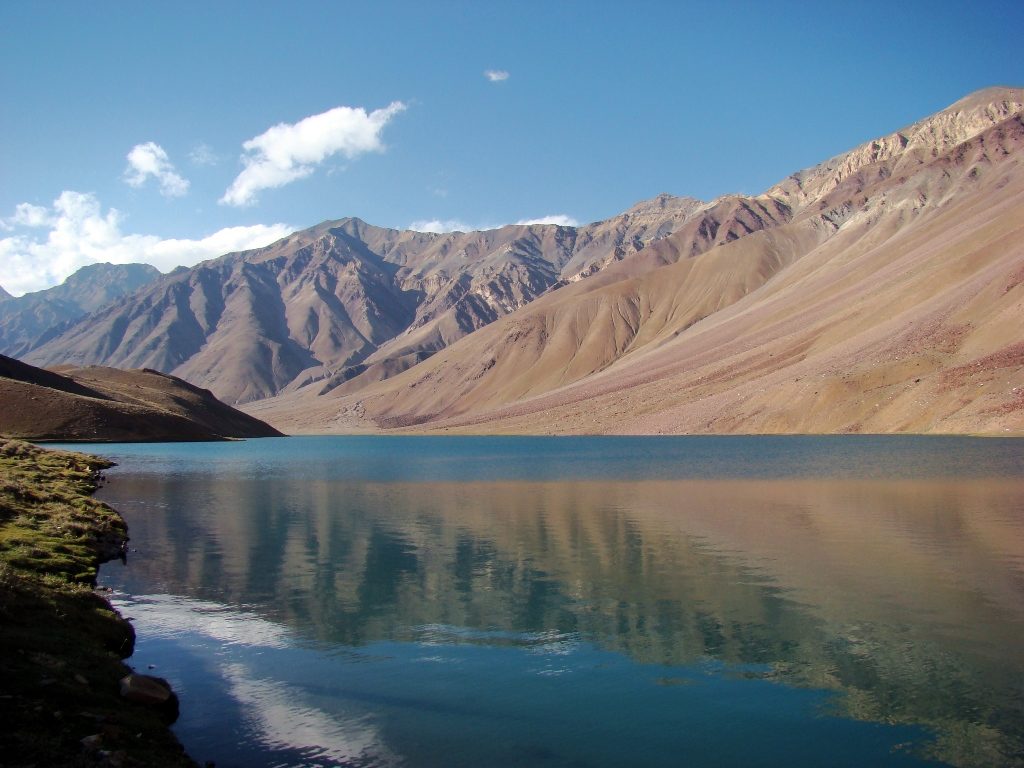
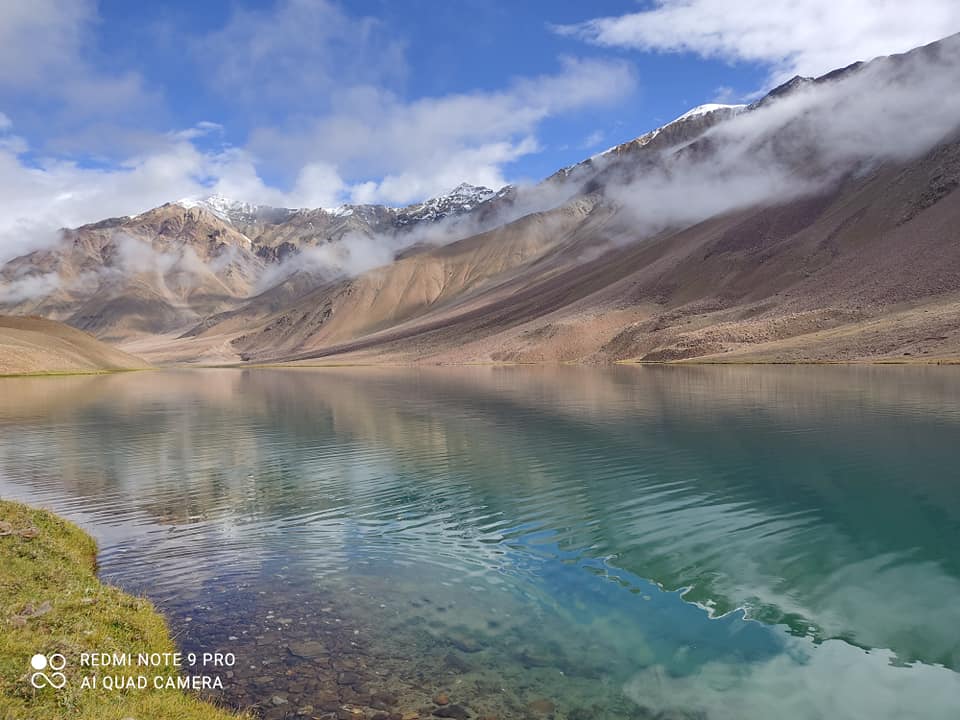
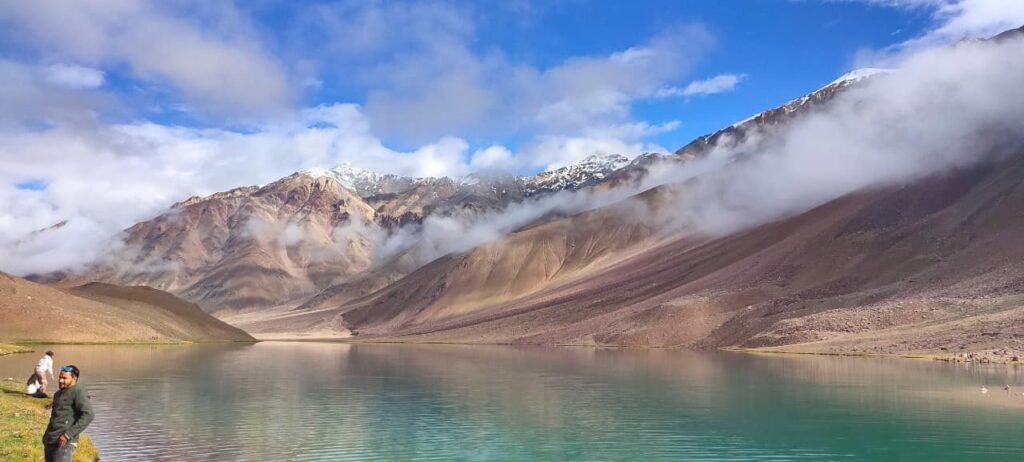
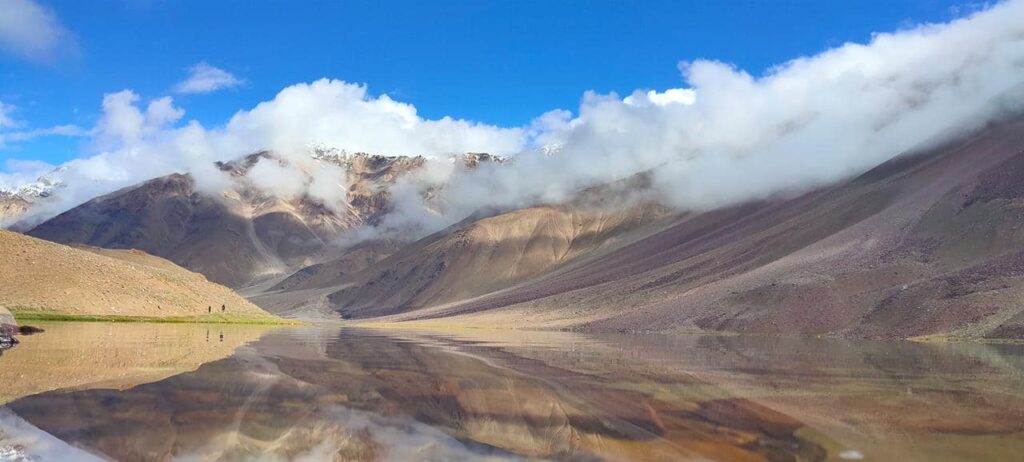
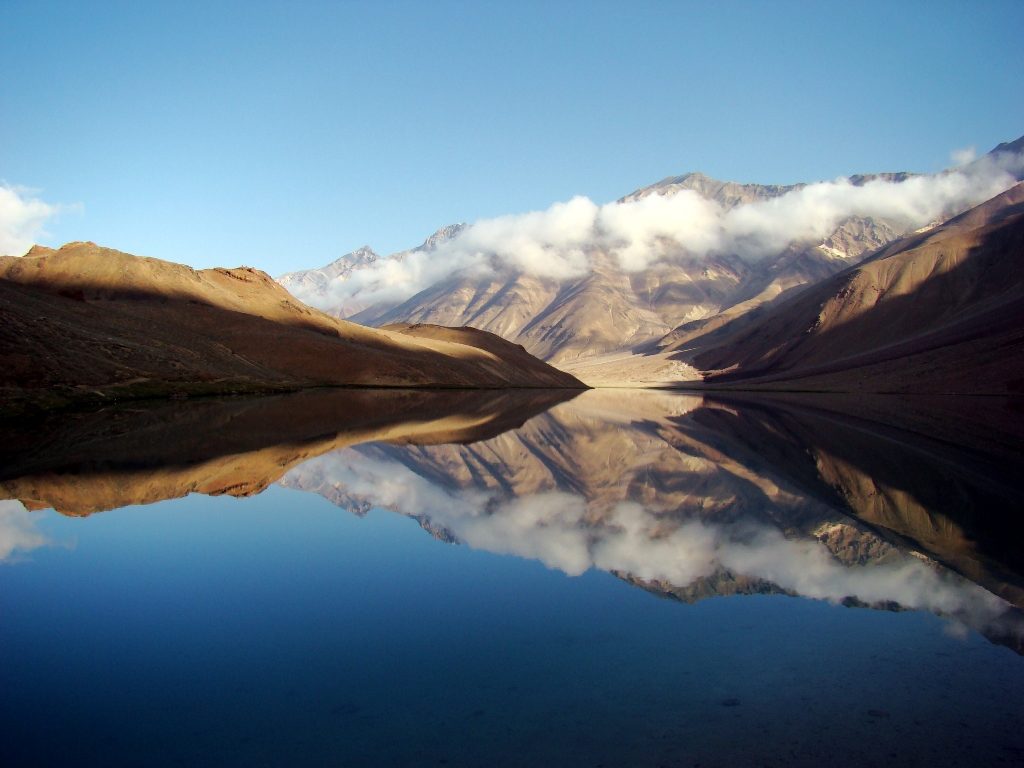
This small lake is one of the key highlights of the journey to Spiti valley and a perfect camping spot. There is also a legend associated with this lake. The confluence of the “moon-born” Chandra and the “sun-born” Bhaga takes place at Tandi, where the fabled Chandrabhaga or Chenab River comes into being.
Interestingly enough, Wikipedia article refer this lake as Tso Chigma. Tso is a Tibetan / Bhoti word which translates to lake, but there is no reference of Chigma either in Tibetan or Bhoti language. A lake is referred to as Dhar in Spiti vernacular language.
Rohtang La
The mighty Rohtang pass, the spot where you will cross over to Manali and finish your Spiti journey. The name of this pass literally means “a pile of corpses” which I believe attributes to the fact that a lot of people died while crossing it in ancient times. Expect to find snow at the top no matter which month you are traveling in. The vistas around from the top of the pass and even on the ascent/descent are quite breathtaking.
Palari Top
Palari (or Balari top) is one and hour hour hike away from Demul village. From this vantage point, one can see about 15 (including Demul) villages of Spiti valley.
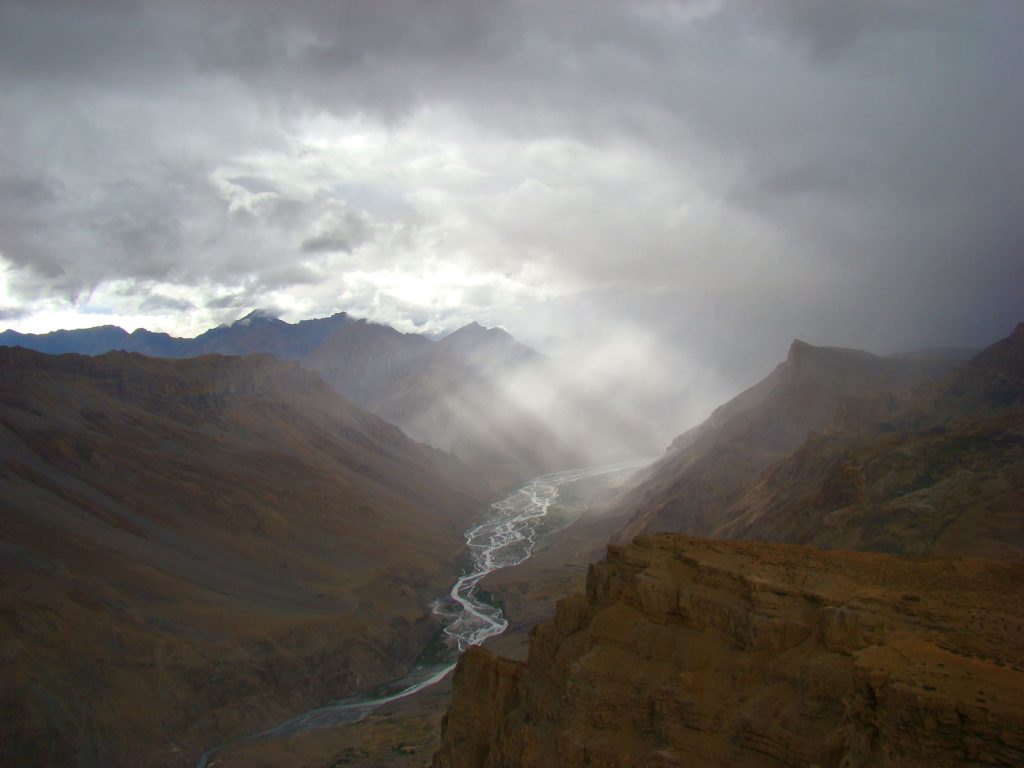
Spiti Road Trip during Summertime
Hit the road on our epic overland journey spanning over ~1200 km, as you traverse seven picturesque districts and explore some of the most sought-after hill stations in Himachal Pradesh. Before venturing into the hidden gems of Spiti valley and Kinnaur, this adventure will take you through breathtaking hill towns like Narkanda, Sarahan, Kalpa. Discover the untamed wilderness of vales like Pin, Hangrang, and Tidong, and marvel at the incredible engineering feat that is the Atal Tunnel. This is an experience of a lifetime, offering a perfect mix of Himalayan beauty, tribal cultural experiences, and adrenaline-pumping road adventure on the old Hindustan-Tibet highway.
FAQs
BSNL cellular network has wider coverage in Spiti valley and Kinnaur, esp in border regions. Reliance Jio, however, offers better internet speed and connectivity in this region.
In summers, the maximum temperature crosses the 20 degrees Celsius mark in Spiti valley. During sunny daytime, you’ll feel comfortable just by wearing a t-shirt and trousers. It is always good to get wrapped in layers of clothes, as the weather can change anytime in the Himalayas. Even if the sun starts shining again, you can always get rid of the outer layers of clothing.
Here is the packing list (summers) for Spiti valley:
T-shirts.
A windcheater/ rain jacket.
Jeans/trousers.
Light woolen.
A cap/hat.
Sunglasses.
A pair of hiking shoes.
3/4 pairs of regular socks.
A water purifier and filtration bottle (avoid plastic bottle).
Personal hygiene essentials.
Sunscreen sunblock cream.
Spiti valley packing list (for winters):
A pair of good quality waterproof trekking boots.
Three pairs of cotton socks.
Two pairs of waterproof hiking pants.
One pair of shorts
Two pairs of fleece jumpers.
Two pairs of thermal tops and bottoms
One down jacket.
Headgear (1 beanie/skull cap, 1 buff, and 1 trekking cap).
A pair of thick gloves
Personal hygiene essentials(alcohol-based gel hand sanitizer, soap, towels, toilet papers, baby wipes, etc.).
UV-block sunglasses.
First aid kit.
A water purifier and filtration bottle.
Spiti valley is acclaimed for its distinctive moon-esque landscapes, Buddhist monasteries and interesting landforms. 5 entities that define the Spiti valley are:
Chandratal — the lake of moon.
Buddhist monasteries of Ki, Kaza, Kungri, and Tabo.
Snow leopards of Kibber —the grey ghost of the Himalayas.
Fascinating Tibetan culture and customs.
Fossils — dating back to the Triassic period (252-201 million years ago) — of Langza village.
Shimla to Narkanda-Rampur Bushahr-Powari-Pooh-Dubling village drive is on National Highway 5 (NH5). The Dubling village to Nako-Tabo-Kaza drive is on NH505. Kaza is the headquarters of Spiti valley. During winters, Shimla-Narkanda-Rampur road gets closed for a day or two whenever there is a long spell of snowfall. During such events, take the Shimla-Suni-Rampur Bushahr route along the Satluj river. This route stays open for all 365 days of the year.
It takes longer — when compared from Manali to Spiti valley (Via Atal tunnel) route — to reach Kaza from Shimla.
Shimla is one of the two places (second is Manali town) to start the Spiti valley circuit tour.
The road from Manali follows the Solang Valley-Atal tunnel-Gramphu-Batal-Kunzum Pass-Losar-Kaza route. The distance from Manali to Kaza is 183 km, and it takes about 6-7 hours (at one go) to reach Kaza. Manali-Kaza is a shorter route than the Shimla-Kaza route.
Though the Atal Tunnel has hardly reduced the road distance between Manali and Spiti valley by nearly 20 km, the drive time between the two places has now been reduced by over 2 hours.
Manali town is one of the two — the second is Shimla — places to start the Spiti valley circuit tour.
You need to follow Ambala-Zirakpur Expressway on National Highway(NH) 44 and Zirakpur to Shimla (111 km) on NH5 in Himachal Pradesh. Shimla to Narkanda-Rampur Bushahr-Powari-Pooh-Dubling village drive is on NH5. Dubling village to Nako-Tabo-Kaza drive is on NH505. Kaza is the headquarter of Spiti valley.
Yes. The circuit is doable in October, though, the weather gets highly erratic — after September — in high altitude regions of Kinnaur, Spiti valley and Lahaul valley.
No. The Manali-Spiti route gets closed when thick layers of snow blankets the Kunzum pass in November/December. The traffic movement resumes only after March month.
Though the Manali to Spiti valley route gets closed — most often after November/early December till March — during winters, the Shimla-Narkanda-Rampur-Nako-Kaza road stays open even during wintertime. During long spells of snowfall, Shimla-Kaza road may get closed for a day or two. BRO team from Project Deepak and local administration employs dozers, snow cutters, and excavators to clear the snow and reopen the route after a spell of snow in the route. Ping us to get the latest road and connectivity updates.
